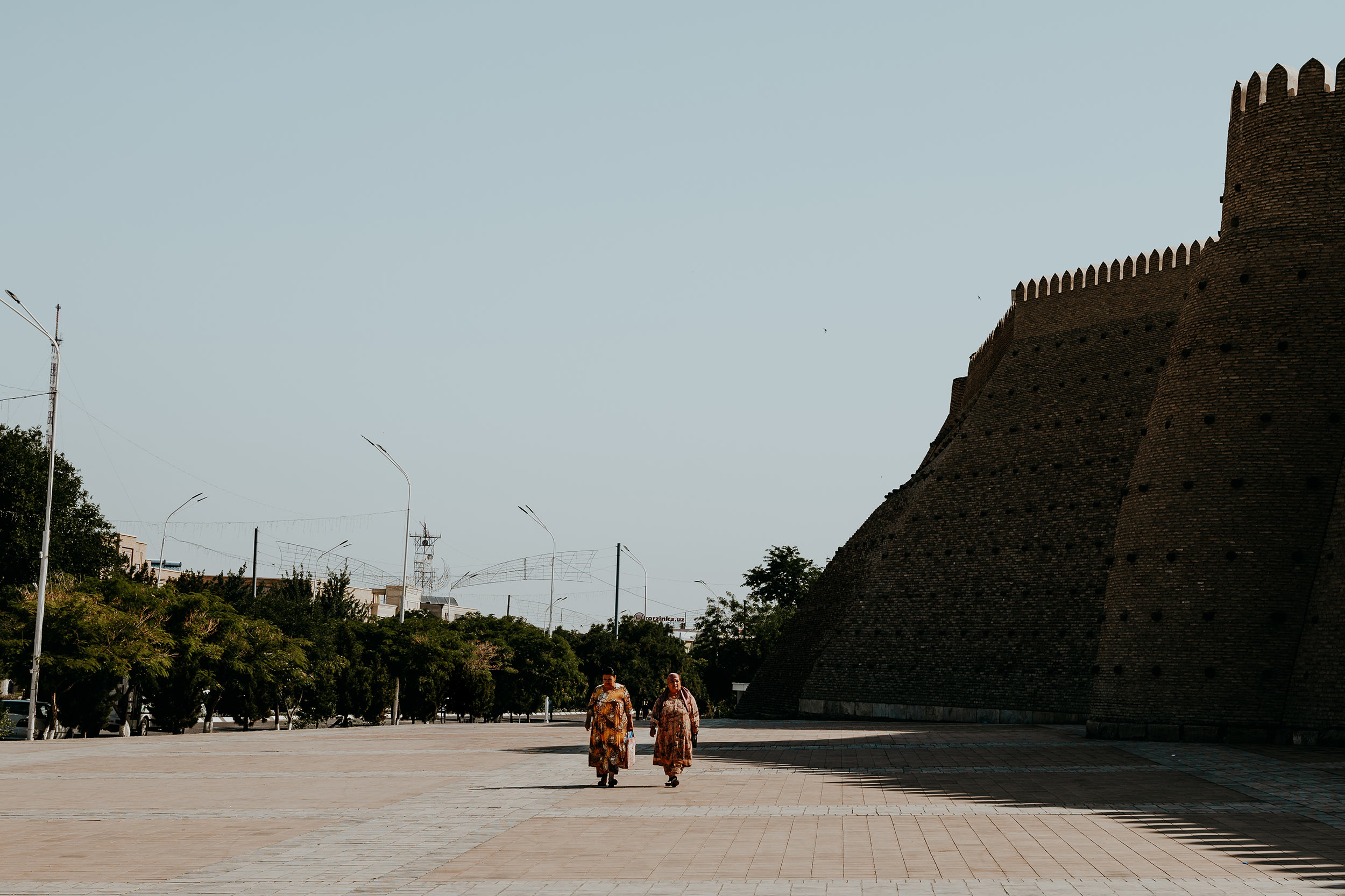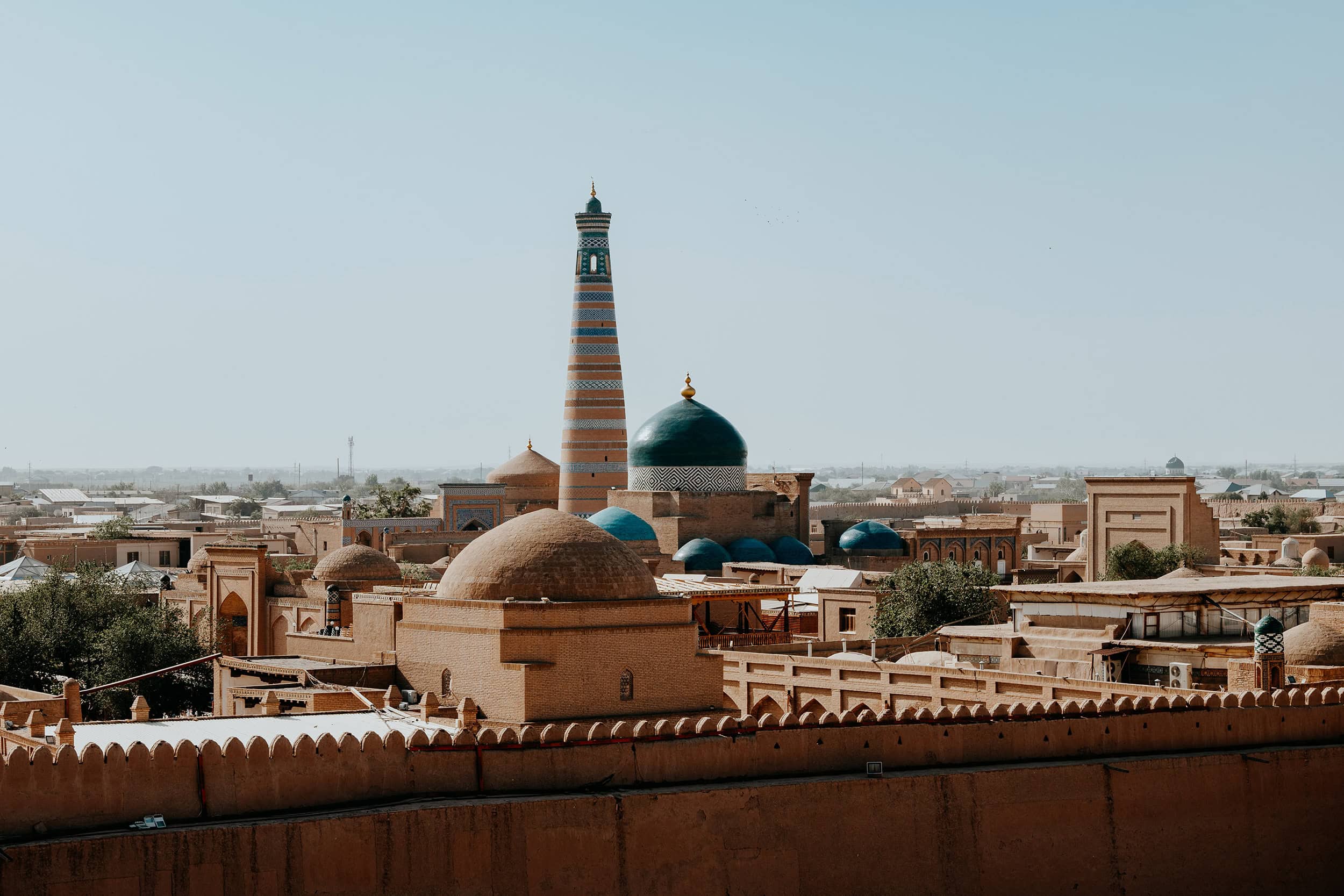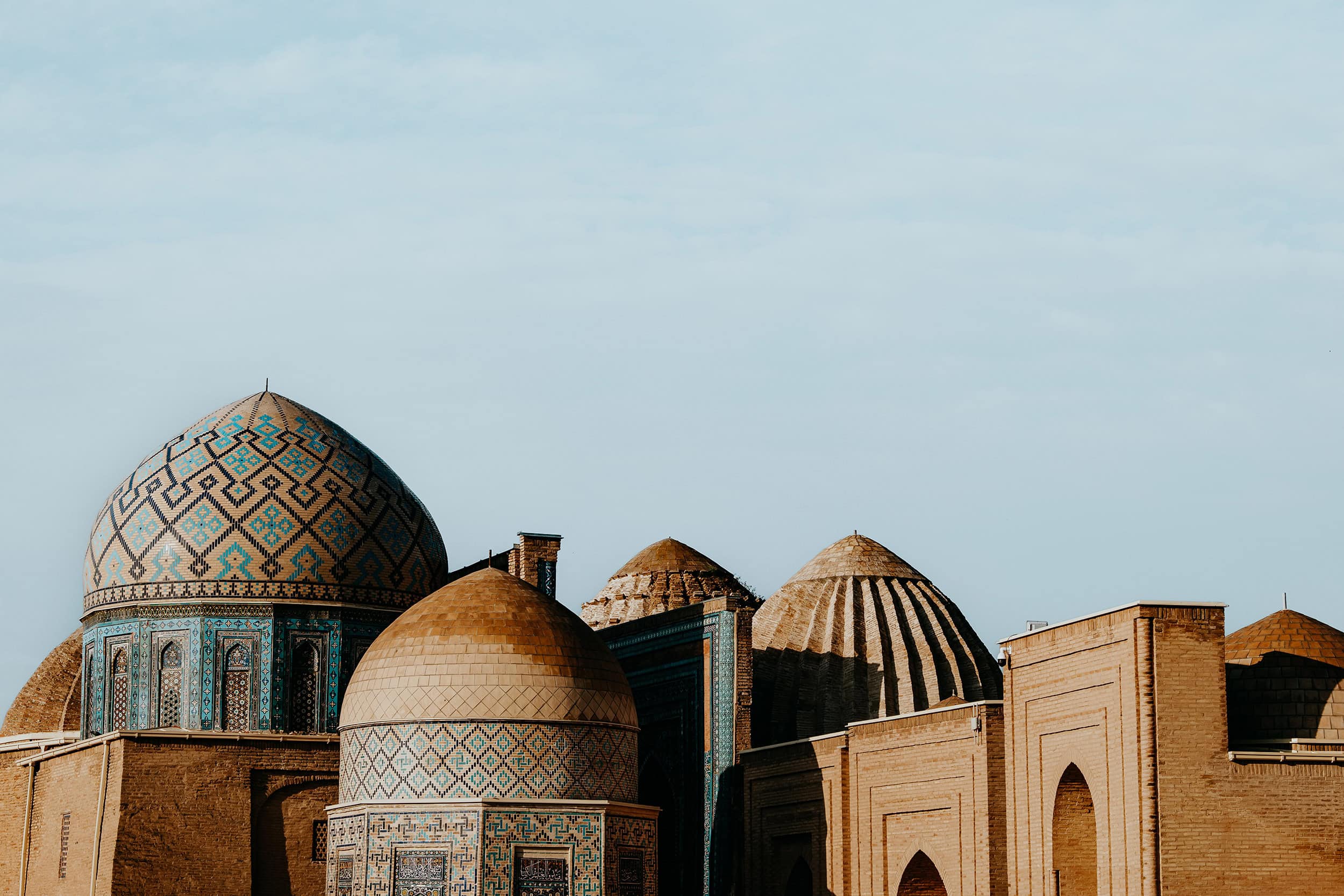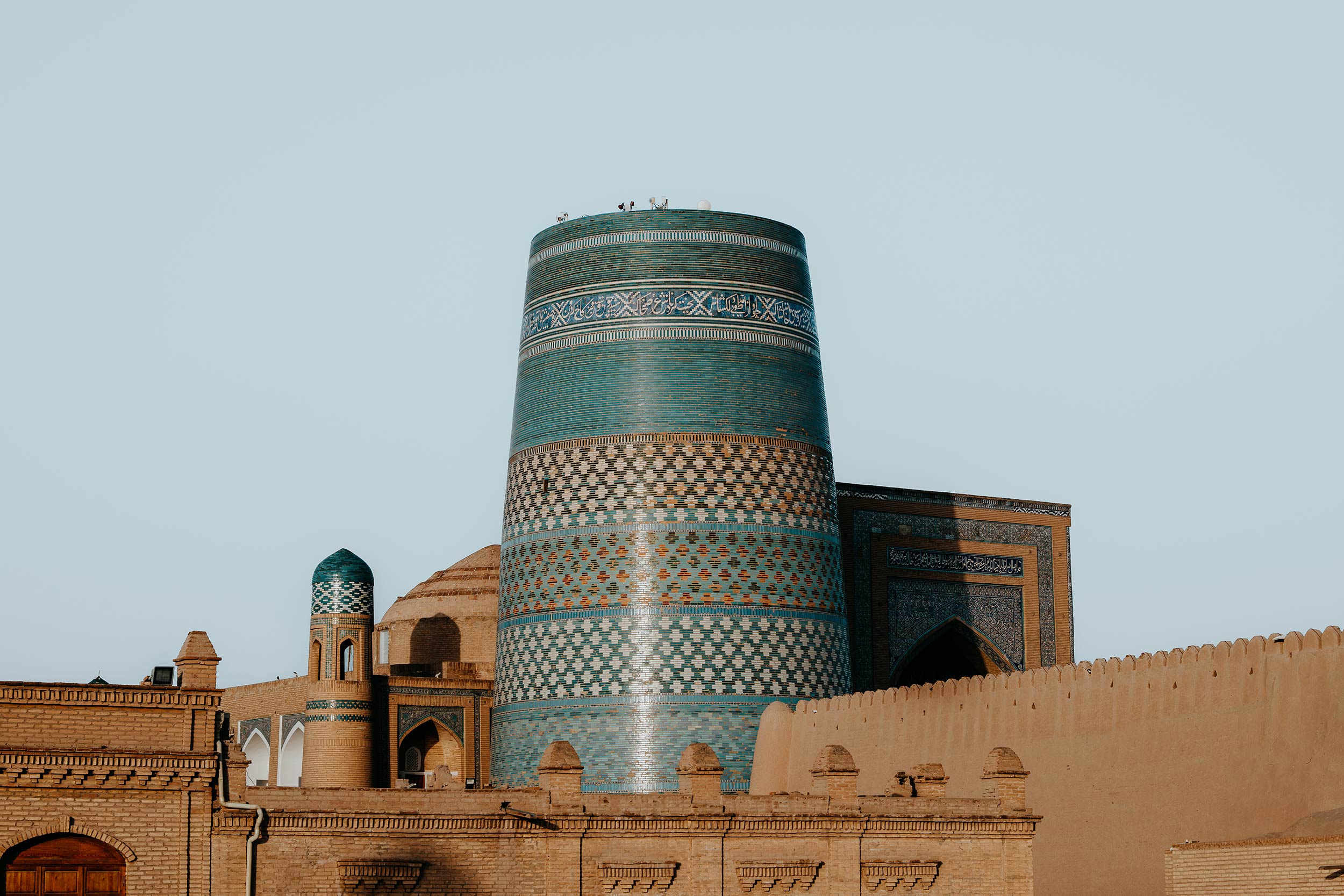Bukhara is a marvellous city that perfectly echoes the tales of years of prosperity and heritage.
The blue-domed madrasas, towering minarets, and time-worn trading domes create a mesmerizing playground for adventure seekers and photography enthusiasts alike, while history and culture buffs will rejoice in centuries of history and mouthwatering culinary treats.
Said to be founded over two millennia ago, Bukhara thrived as a centre of trade, scholarship, and religion, and its strategic position along the famous Silk Road turned it into a captivating melting pot of cultures, beliefs and influences – which are still very much felt today.
The UNESCO World Heritage-listed city boasts over 150 well-preserved monuments, including the enormous Bukhara Ark, the intricate Bolo Hauz Mosque, and the utterly fascinating Po-i Kalyan Complex to name a few – each effectively narrating tales of a bygone era.
It is more than evident that Bukhara is exceptional. To help you make the most of your time here, I’ve curated my take on the best things to do in Bukhara and melted them into an in-depth, yet bit-sized guide.
See this guide as your cheat code to Bukhara, where I share everything from where to stay, how to visit, how to get there, and when to visit, as well as a few of my first-hand tips – enjoy!
If you choose to use any of the links on this page, I may receive a small commission at no extra cost to you. By using these links, you’ll have a direct impact on WTSW and my ability to continue to create free insightful travel content for you. If you find any of my tips useful, you can support me by buying a virtual coffee here.
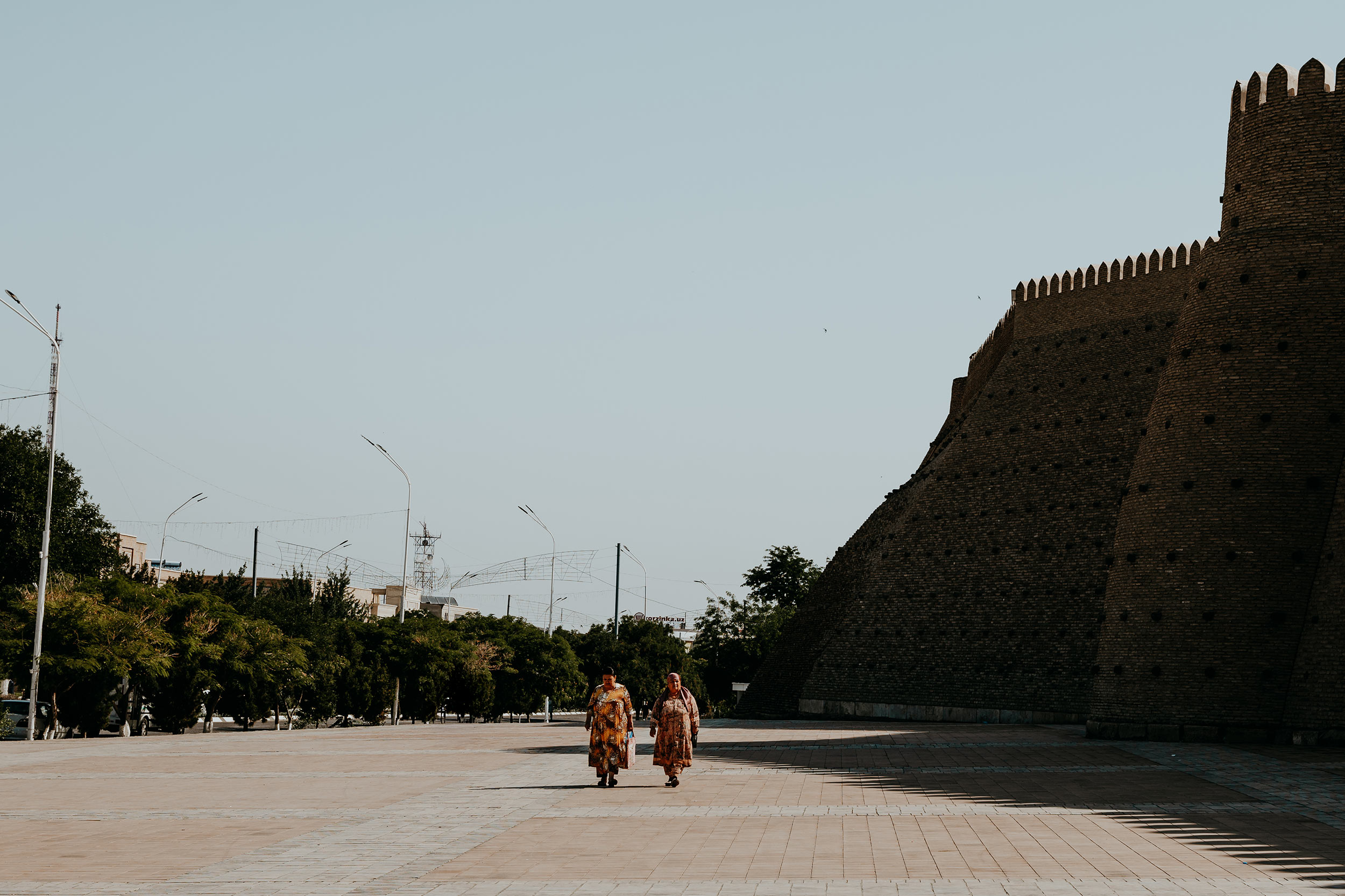
Where is Bukhara
Bukhara is nestled within a lush oasis in the Zerafshan River Delta, in the heart of Uzbekistan.
Home to approximately 280.000 residents, Bukhara was once a vital trading hub along the ancient Silk Road, facilitating trade and cultural exchanges between Asia, the Middle East, Africa and Europe.
With a history of over two centuries, some of the best preserved Silk Road architecture, and a legacy that is influential in every sense of the word, Bukhara’s historic centre was set to receive the prestigious UNESCO World Heritage site status in 1993.
Where to stay in Bukhara
As one of the most popular destinations in Uzbekistan, Bukhara has plentiful accommodation options within its time-worn streets.
Whether you’re looking for a boutique stay, a budget-friendly hostel, or something more lavish, it doesn’t require too much effort to find something that matches your travel style, budget and unique set of needs.
To make things even more effortless for you, I’ve curated some of my favourite finds below:
Mercure Bukhara Old Town | Situated in Bukhara Old Town, Mercure is one of the pioneers when it comes to upscale accommodation in Bukhara. Inspired by local heritage, the hotel mixes authentic design elements with Mercure’s high level of comfort and hospitality. With spacious rooms, comfortable beds, a spa and wellness centre, and a fitness centre, Mercure is the ideal base from which to discover Bukhara.
Kukaldosh Boutique Hotel | A pleasant boutique stay only a short walk from all the things to do in Bukhara, Kukaldosh is easily one of the best options within the historic old town. The interior design is traditional, colourful and cosy, creating an overall calm and welcoming feel. It’s the perfect spot for those who seek comfort while also having the old town at their doorsteps.
As-Salam Boutique Hotel | If you’re looking for something a little more local, look no further, and be sure to take a look at this minimal yet authentic boutique hotel at the core of Bukhara Old Town. Traditional in every aspect of the word, As-Salam is a banger of an option, with spacious rooms, a large inner courtyard, an absolutely yummy breakfast spread, and, last but not least, a top-tier location near all the popular sights in Bukhara.
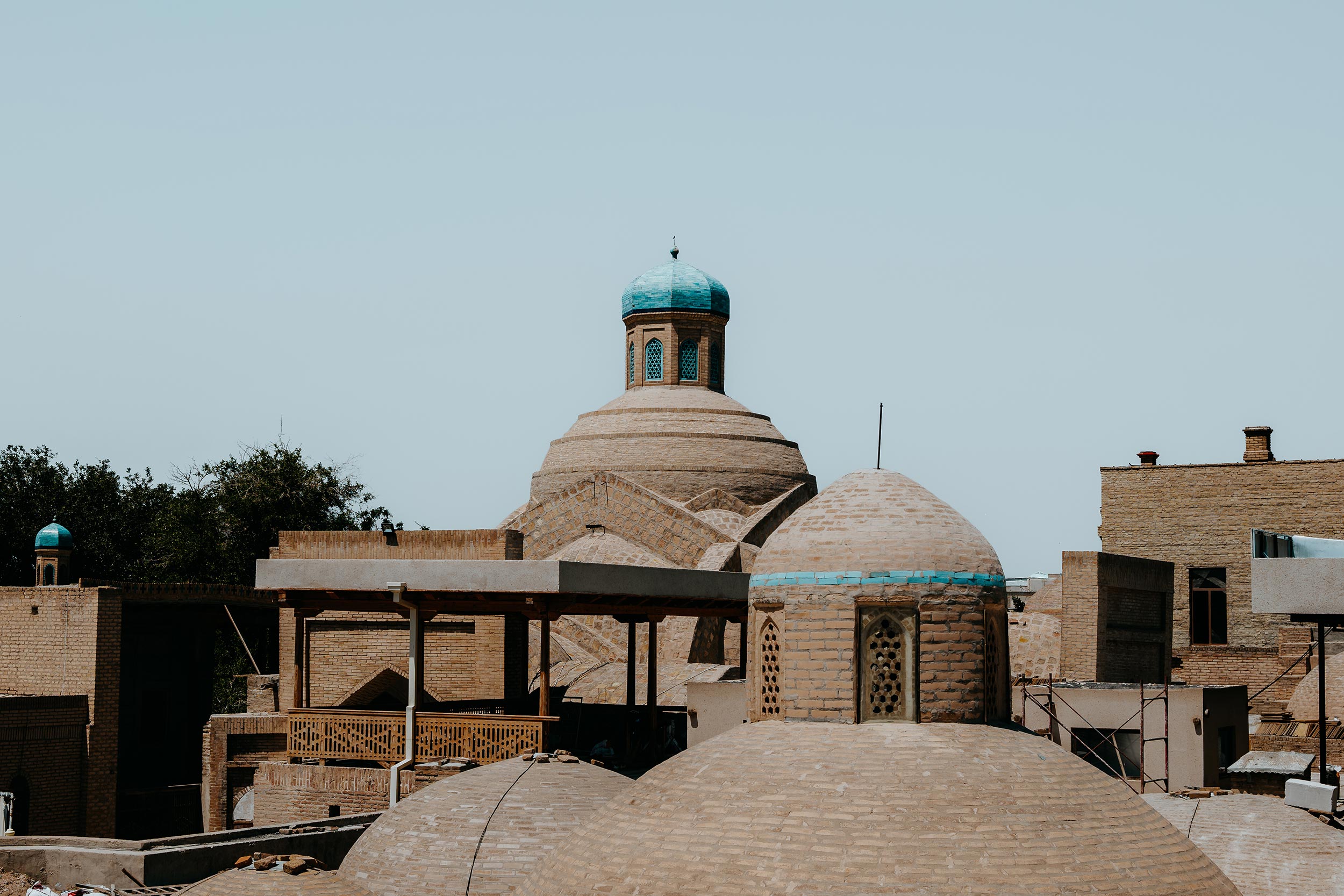
10 Things to do in Bukhara, Uzbekistan
1. Explore the mesmerizing Po-i Kalyan Complex
Easily one of the most appealing reflections of Bukhara’s grandeur, the opulent Po-i Kalyan Complex is as stunning as any I’ve seen during my time travelling Uzbekistan.
Situated smack bang in the heart of the historic centre of Bukhara, this complex is home to the incredibly fascinating Kalan Mosque; one of the largest mosques in Central Asia, with a whooping capability to house up to 12.000 devoted worshippers.
But it’s not just the Kalan Mosque that turned the complex into one of the absolute best things to do in Bukhara. No, the complex is home to not just two, or three, but four monumental masterpieces, each truly magnificent in their own right.
First, there is the Kalyan Minaret, a towering minaret built in 1127 that still dominates the Bukhara skyline until this very day. Standing at 47 metres, this was once the tallest structure in Central Asia.
Then there is the Mir-i-Arab Madrasah, situated adjacent to the Kalan Mosque, this active mosque is one of the most respected spiritual Islamic universities in the post-Soviet territory, and truly a beauty to behold – but solely from the outside, as it is not allowed to enter.
Last, but not least, there’s the Emir Alim Khan Madrasah, a relatively small structure, yet nothing short of impressive and defined by utterly stunning geometric patterns and its iconic octagonal baked brick domes.
There’s no denying that the Po-i Kalyan Complex is absolutely breathtaking, and therefore it is little surprise that a slow roam around its ancient grounds is written atop many travellers’ bucket lists for Bukhara.
Where | Po-i Kalyan
Opening hours | Daily 0900 – 1800
Entrance fee | 10.000 SOM (€0,75) per person
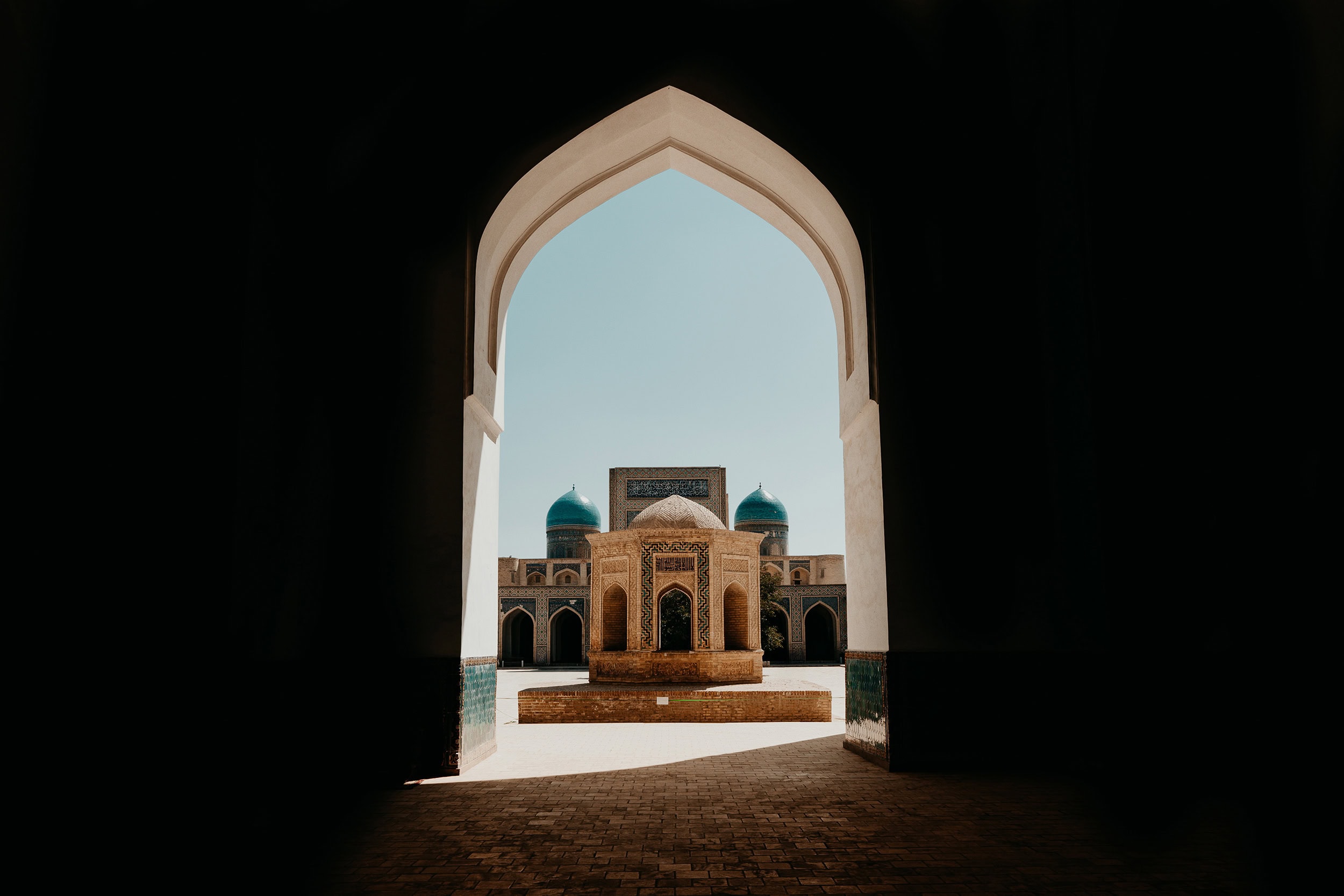
2. Visit the Photo Gallery Shavkat Boltaev on Jubar Street
If you’re anything like me and appreciate all things the artistic side of life, a visit to the Photo Gallery of Shavkat Boltaev will most probably pique your interest.
Situated on Jubar Street this small yet interesting photography gallery offers a unique glimpse into both the history of Bukhara and the incredible work of the late Shavkat Boltaev.
Born and raised in Bukhara, Shavkat Boltaev was not solely a photographer, but also a more than capable contemporary artist, focusing mostly on abstract acrylic paintings.
But it was in the field of photography where Shavkat truly excelled, earning him various important awards throughout his career, including the famous exhibition; “The Jews of Bukhara”.
Today, many of his works are found in his quant little photo gallery here in Bukhara, and as a photographer myself, seeing Bukhara through the eyes of a local legend was truly inspiring.
Where | Photo Gallery Shavkat Boltaev
Opening Hours | Monday to Saturday 0900 – 1930, Sunday 0930 – 1930
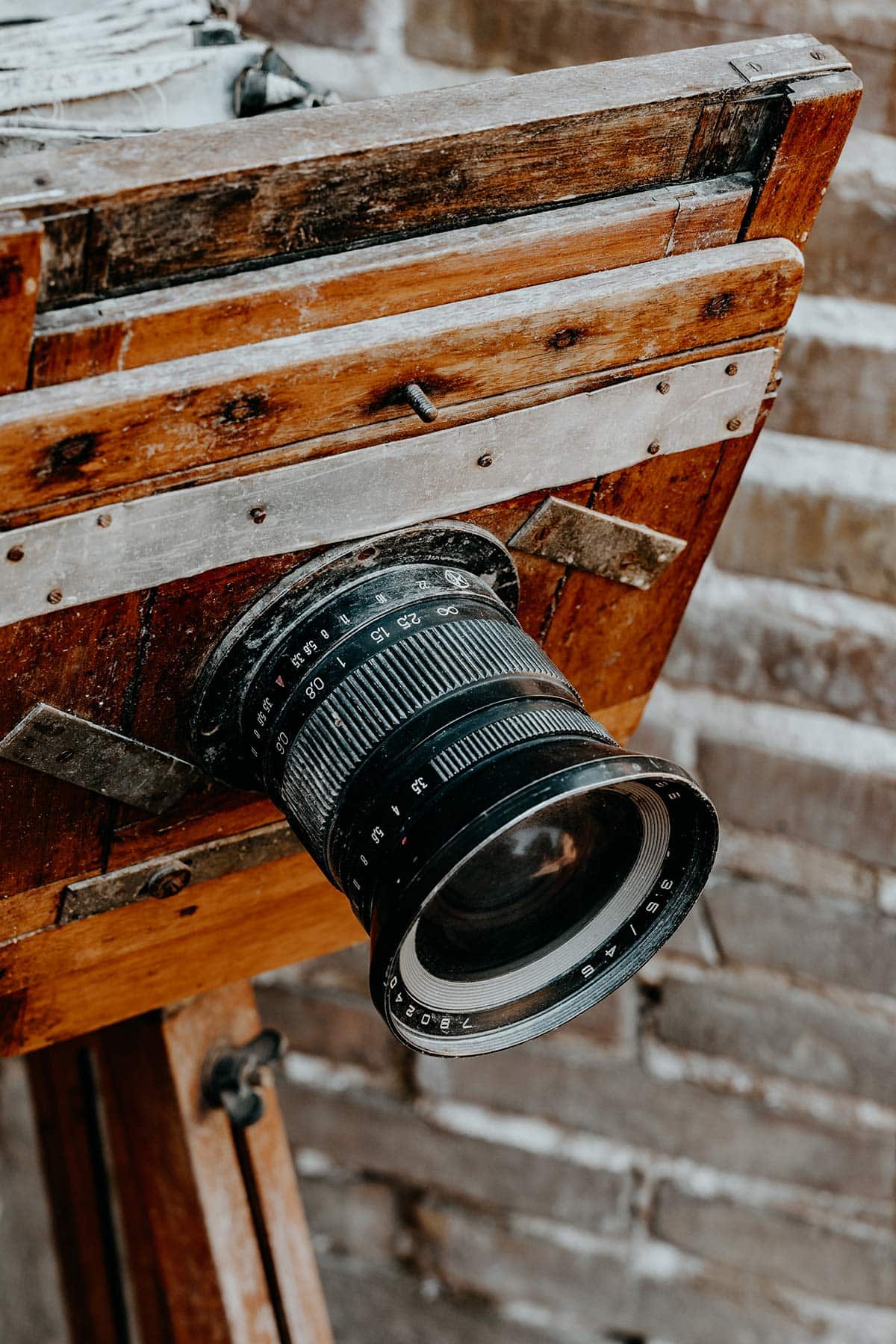
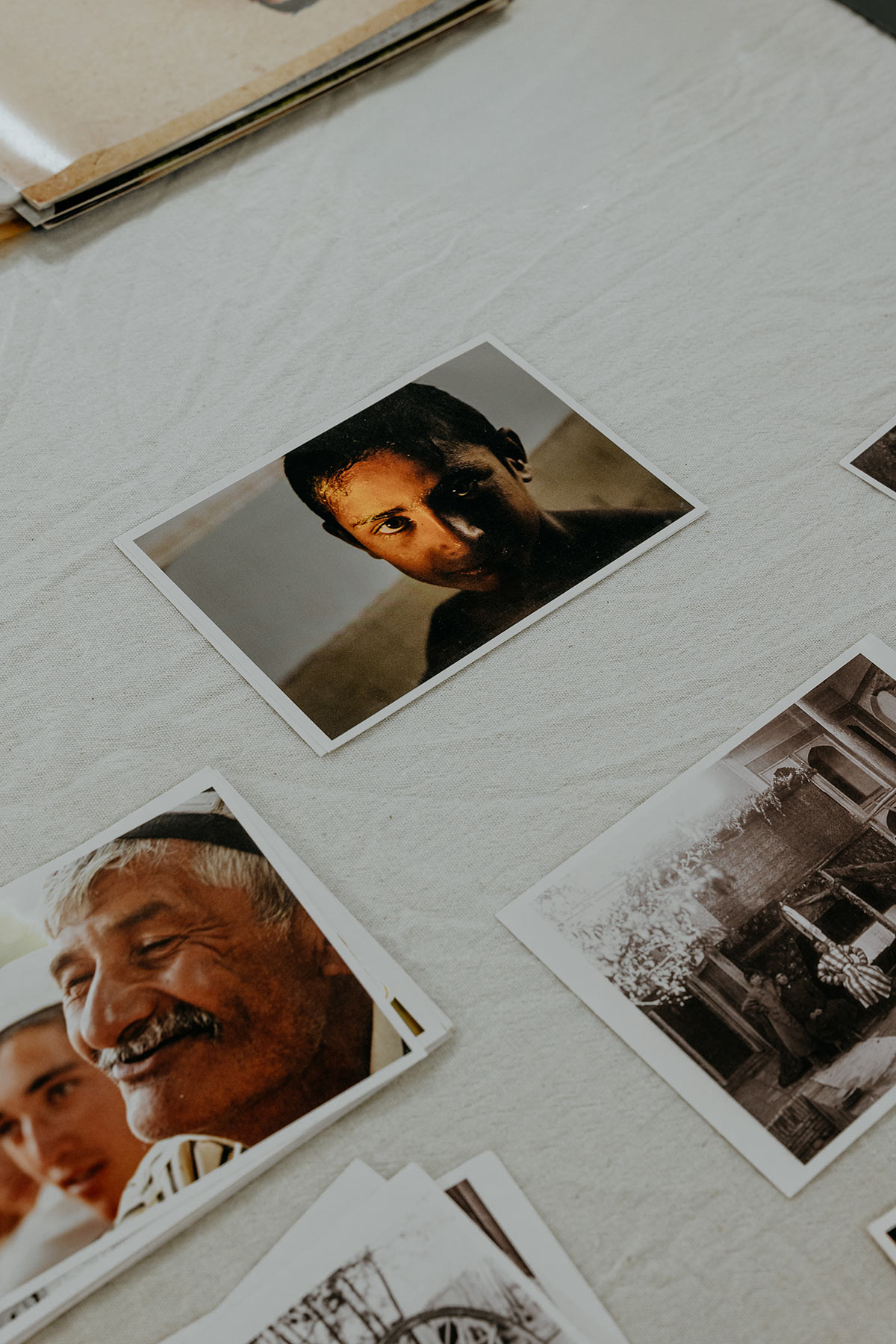
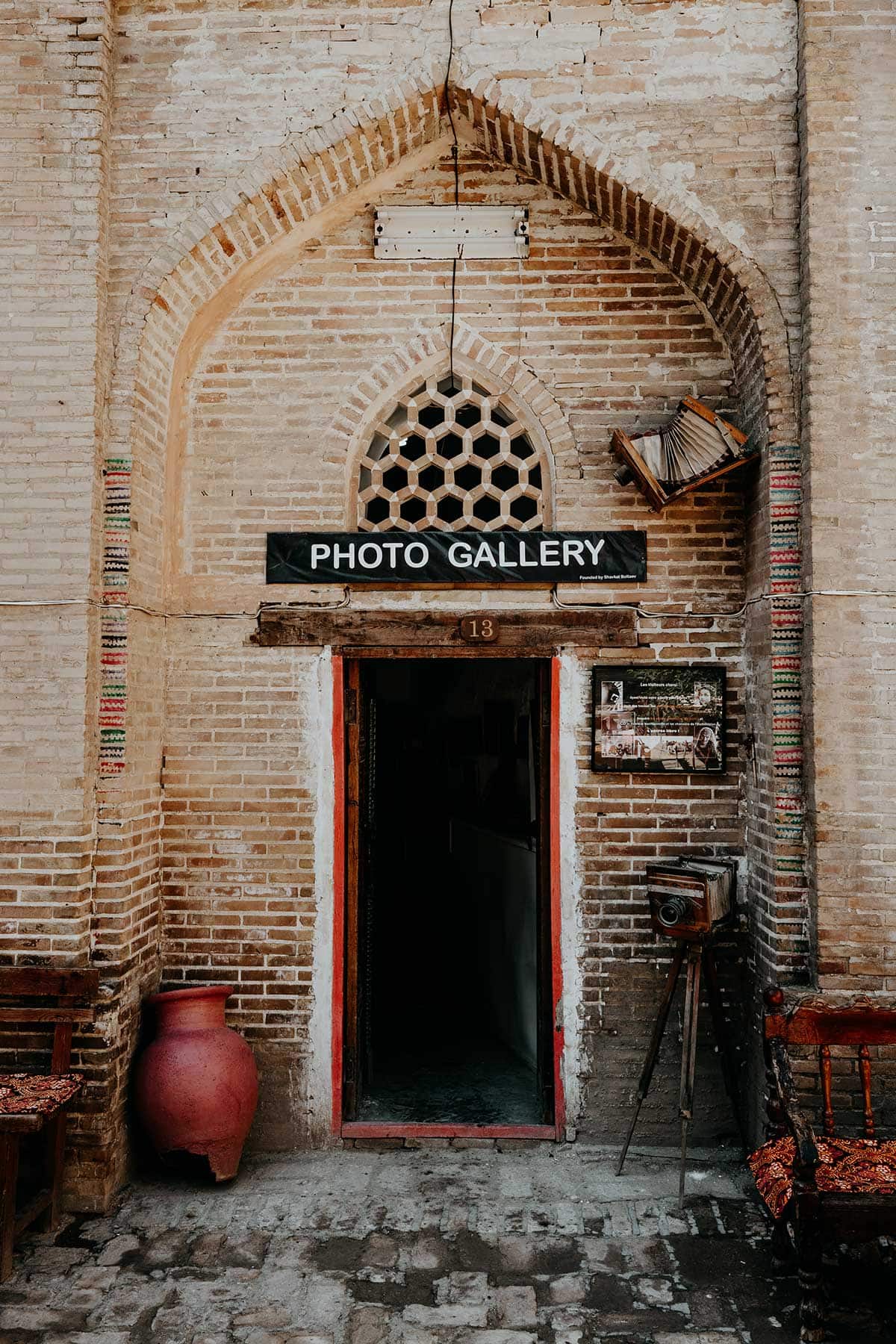
3. Behold the imposing Ark of Bukhara
While the opulent madrasahs and towering minarets are Bukhara’s main lure, the Ark of Bukhara is truly a spectacle in its own right.
Imposing, iconic and intriguing, the fortified citadel once housed the royal residences of the Bukhara Khans, besides the town’s impressive military complex.
The enormous Bukhara Ark dates back as far as the 5th century, which led many to believe that it’s the oldest structure in Bukhara.
Throughout its extensive historical timeline, Bukhara, and accordingly its fortress, had been troubled by many conquerors, battles and wars, causing an endless cycle of obliteration and reconstruction.
At present, much of the west side of the Ark is preserved as it was back in the day, and inside you can see the Friday Mosque, the Reception & Coronation Court, as well as a few small exhibitions showcasing historical artefacts.
Personally, I believe the interior is a little underwhelming, and for that reason, I believe the Ark is best admired from either the summit of the Bukhara Tower or by taking a leisurely walk around its massive walls.
While I encourage you to find out for yourself, instead of following my advice blindly, I do feel you wouldn’t miss anything noteworthy if you do decide to skip entering the citadel.
Where | Ark of Bukhara
Opening hours | Daily 0900 – 1800
Entrance fee | Entrance to the Ark is 30.000 SOM €2,- per person
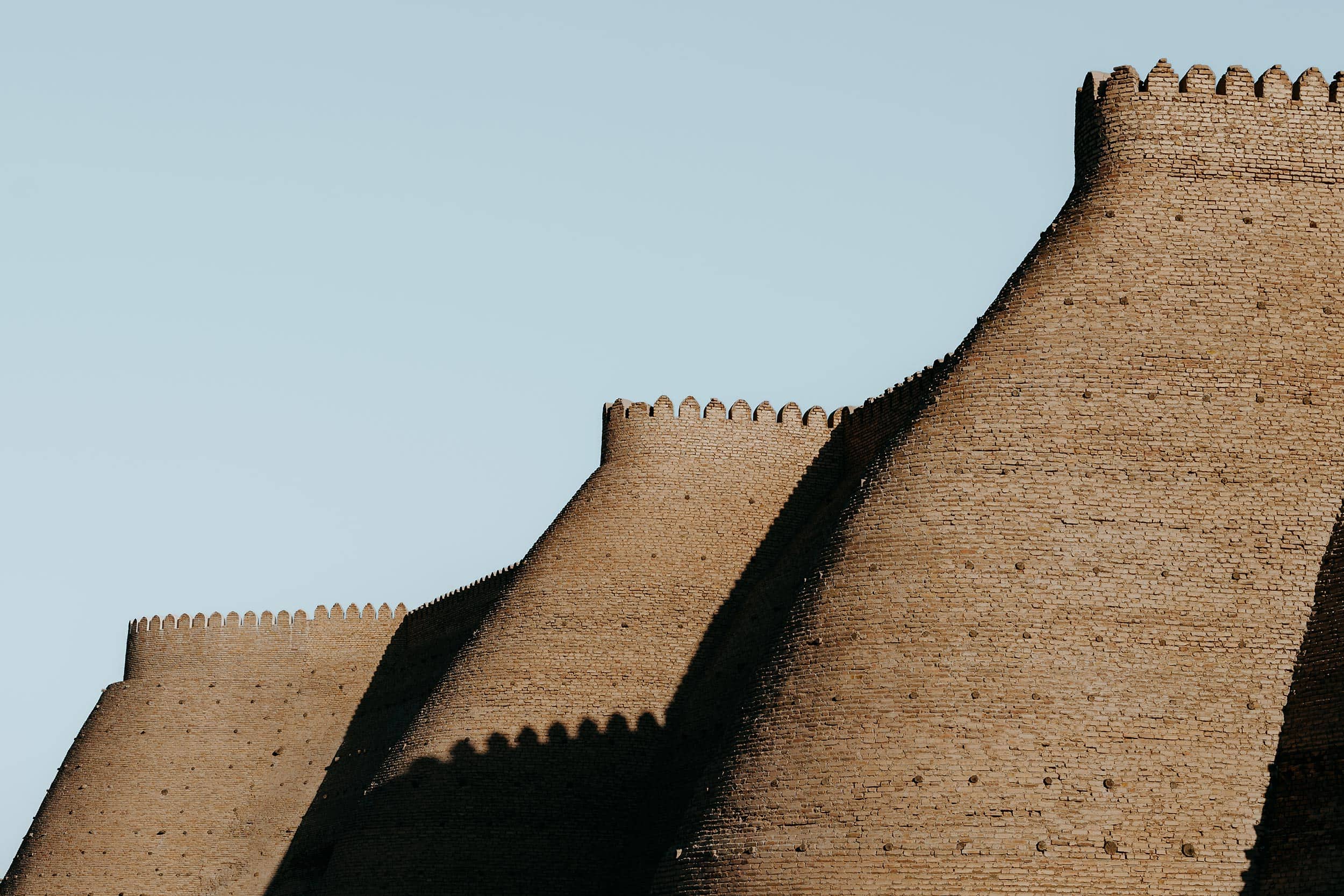
4. Roam around the historical centre
Roaming around Bukhara Old Town for the first time is nothing short of amazing, as the architectural magnificence of the bygone Silk Road era reveals itself at just about every corner, creating an unrivalled, nostalgic atmosphere.
Of course, there are heaps of interesting things to see and do in a place like Bukhara, but as with so many things in life, the real charm is often found in its simplicity.
Taking a leisurely morning walk around Bukhara is one such thing.
You see, roaming around the time-worn streets without a plan and being part of the unique day-to-day moments, is just something no ancient building, local restaurant, or trendy cafe can compare to – especially if it also happens to be a city you eagerly desired to explore for a long, long time.
While I encourage a roam without a plan, some of the sites I would mark down include:
Lyabi Khauz | Nestled in the heart of Bukhara Old Town, Lyabi Khauz is an inviting square where both locals and tourists hang out throughout the day. Not surprisingly, it’s also where you’ll find lots of restaurants, souvenir shops and tea houses.
Nadir Divanbegi Madrasah | Adjacent to Lyabi Khauz is the Nadir Divanbegi Madrasah, a late 16th century that was constructed during the Ashtarkhanid dynasty. Legend has it, that it was initially built as a caravanserai, before they transformed it into the madrasa we see today.
Mizro Ulugbek Madrasah | Constructed in 1417 by renowned astronomer and ruler Mirzo Ulugbek, this impressive madrasah is said to be the oldest surviving madrasah in Central Asiam and a true testament to the architecture splendour of the Timurid era.
Abdulaziz Khan Madrasah | Unlike many of the madrasahs found in Uzbekistan, the colourful facade of the Abdulaziz Khan Madrasah is adorned with unusual mosaics portraying mythical creatures, including a Chinese dragon and a Simurg; a bird of happiness.
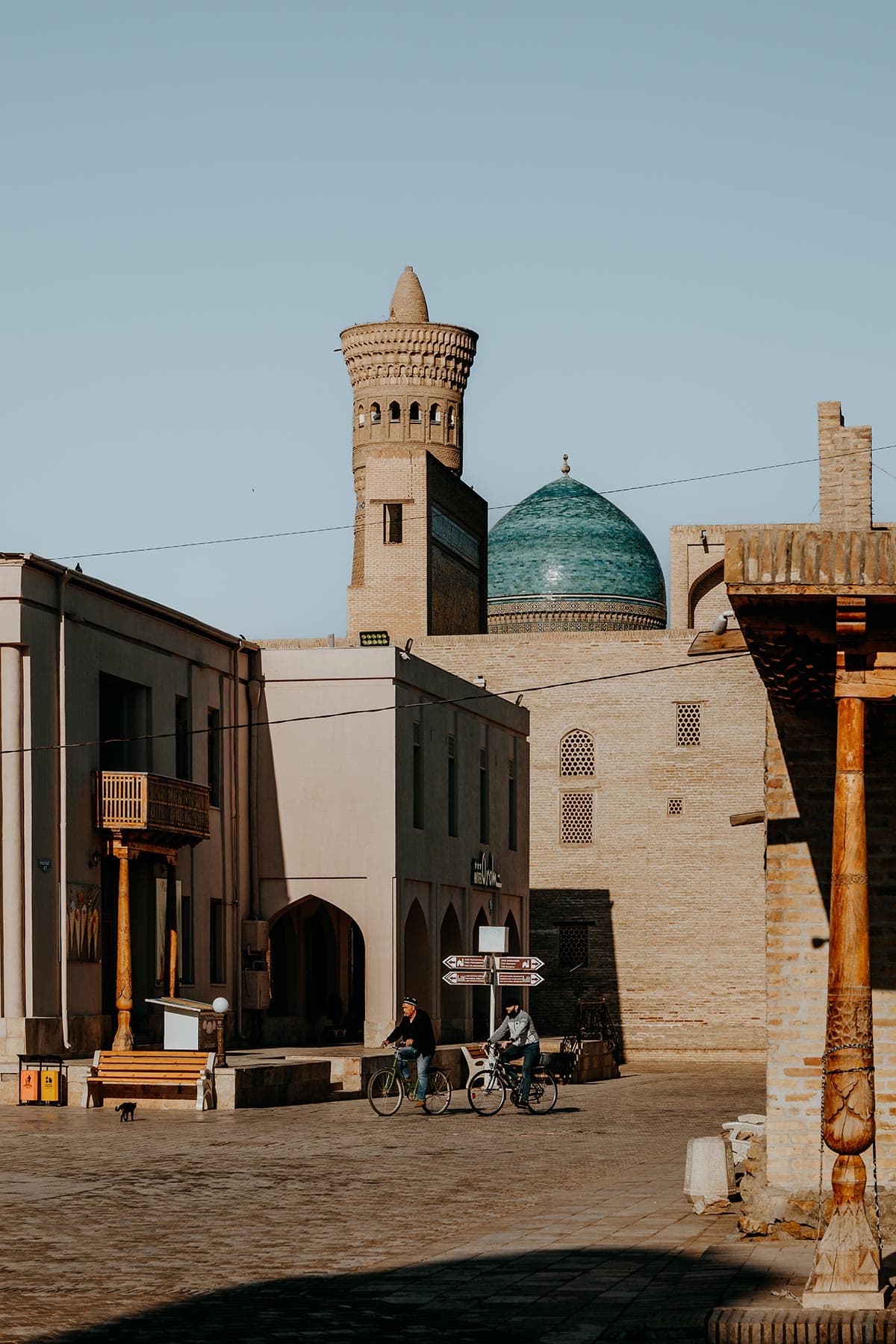
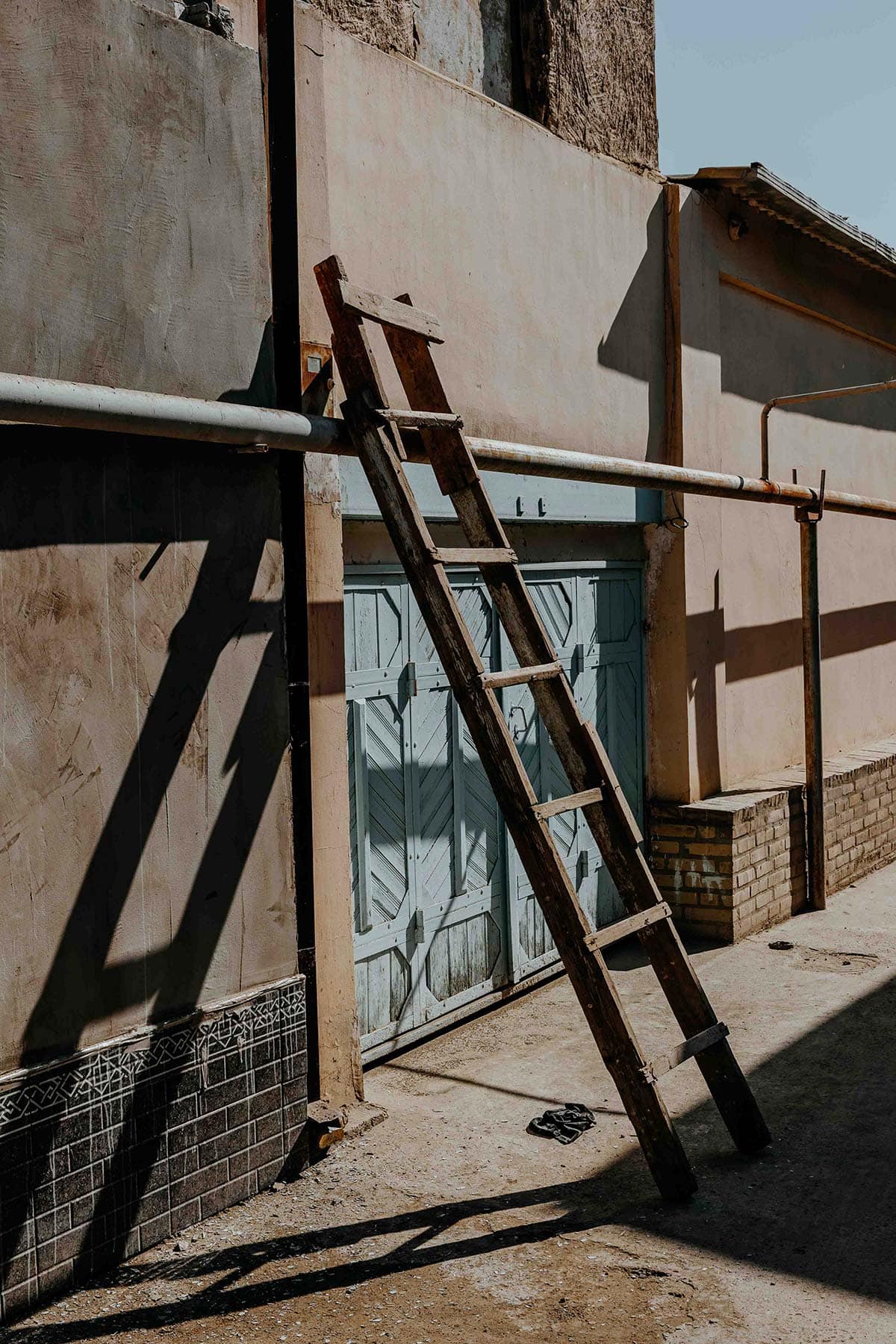
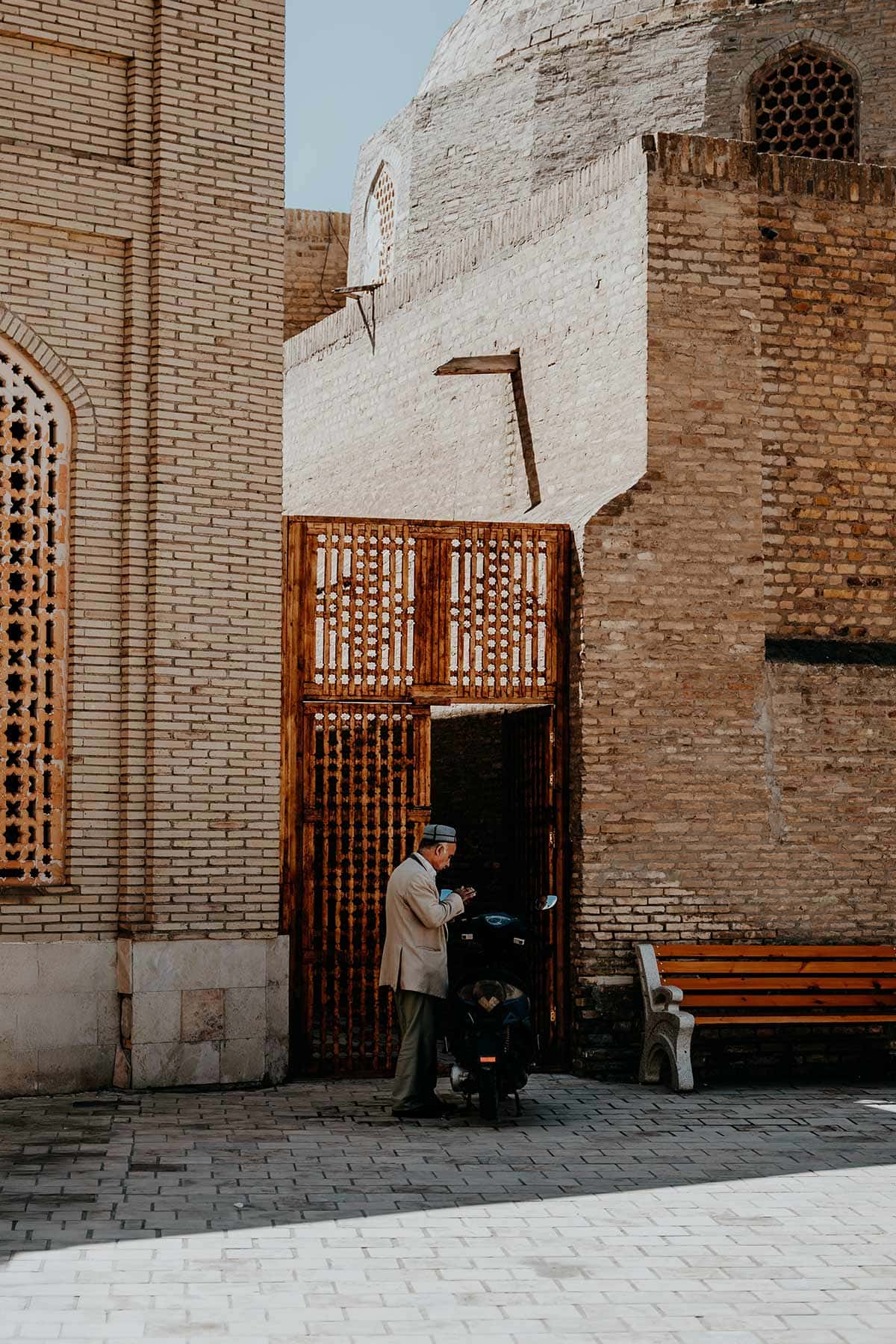
5. Marvel at the intricate Bolo Hauz Mosque
Adjacent to Bukhara Ark lies the Bolo Hauz Mosque, a downright impressive mosque that displays exquisite examples of Central Asian Islamic architecture.
Also known as the ‘Mosque of Forty Pillars’, Bolo Hauz was first built in 1712 to serve as a Friday Mosque, but it wasn’t until the beginning of the 20th century that they decided to add the iwan at the front of the mosque.
Those who look a little more closely will realise that the mosque has only 20 pillars, yet the reflection of the crystal clear water of the Hauz (Persian for pond) in front of it doubles that down to 40, which justifies its name; the ‘Mosque of Forty Pillars’.
The mosque itself is defined by the best of craftsmanship, with stunning artwork throughout; intricate ornaments decorated with flowers, exceptional geometrical patterns, and impressive wooden pillars perfectly carved out of massive chunks of walnut and elm.
While the mosque is stunning, it’s the reflections provided by the pond that make it even more enchanting, as it adds a significant touch of serenity to the mosque and its surroundings.
Where | Bolo Hauz Mosque
Opening hours | Bolo Hauz is an open-air mosque
Entrance fee | Free
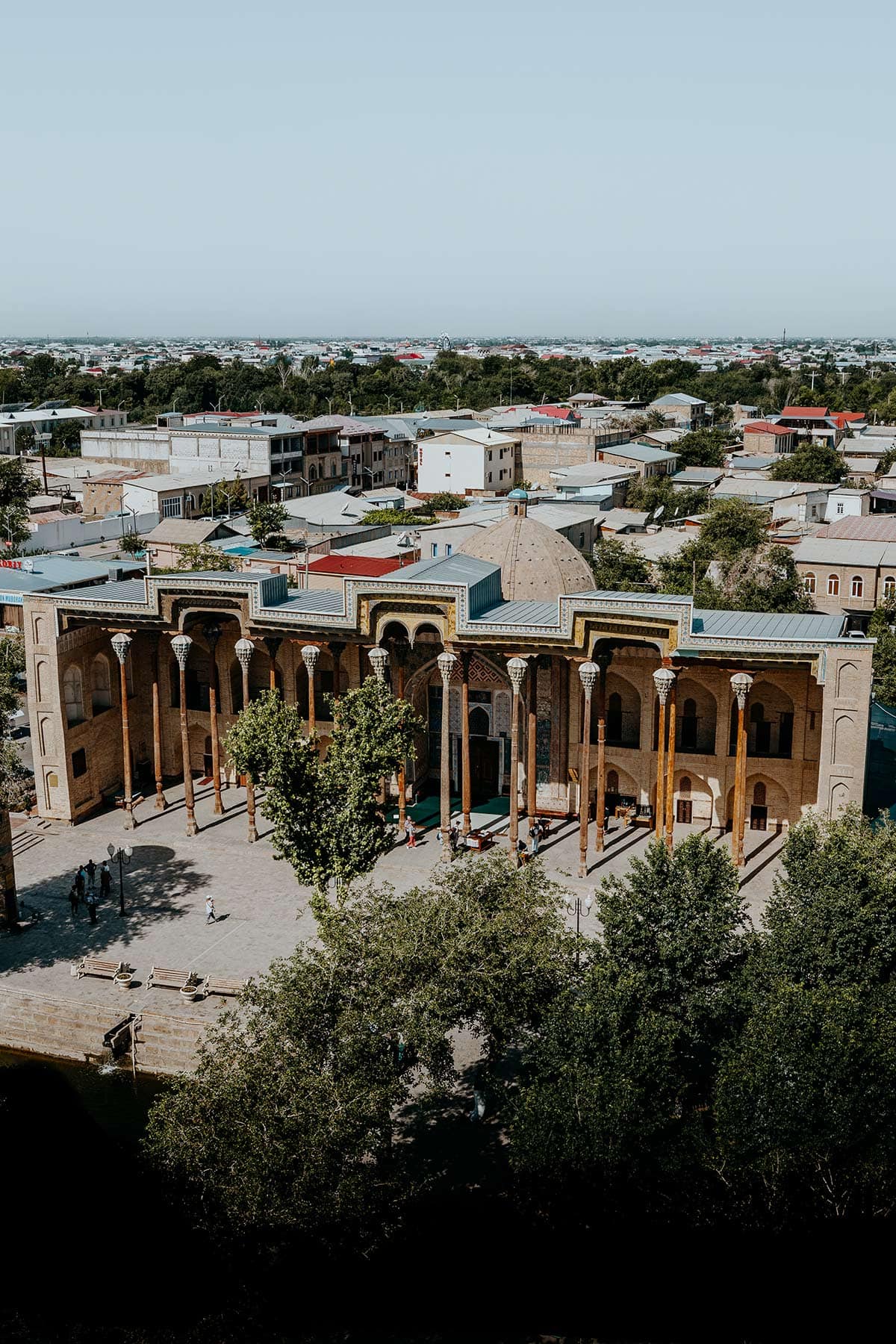
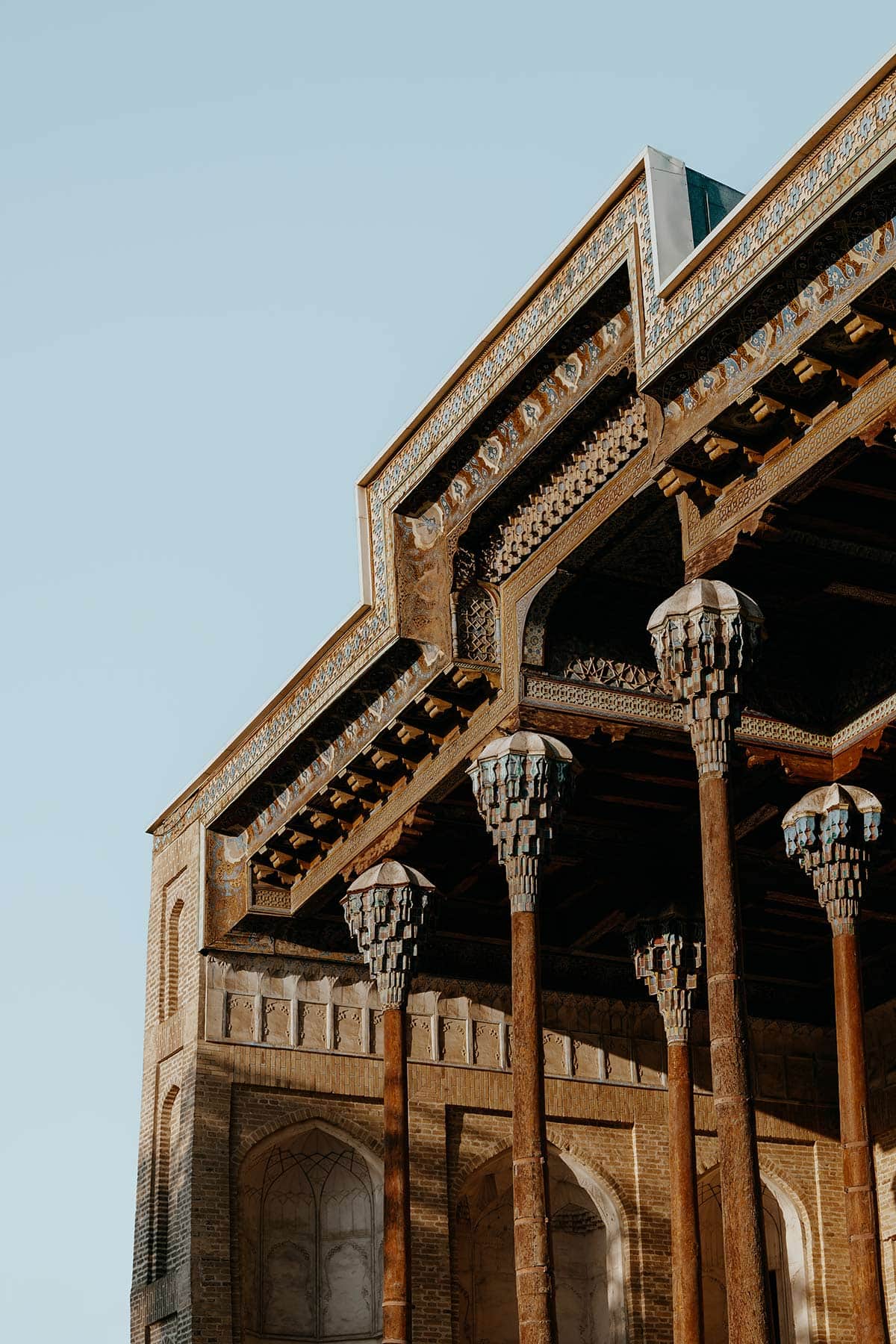
6. Roam around the Toqi Telpak Furushon Bazaar
After travelling to Central Asia quite a few times over the past few years, I learned how much of the region’s everyday life is moving around its lively market stalls, intoxicating bazaars, and the goods often found there.
Like all of Uzbekistan’s treasured Silk Road cities, Bukhara was once a prosperous trading hub along the iconic Silk Road, and its legacy as a seat of trade is still very much present today.
One of the best places to get a feel for Central Asia’s deeply rooted trading traditions is under the roofs of Toqi Telpak Furushon, a large, domed bazaar where in bygone days, merchants from India, Russia, China, and Iran among many others use to assemble to sell or trade their goods.
Today, locals and travellers alike are still very much drawn to the age-old grounds of the Toqi Telpak Furushon bazaar, as its unique configuration echoes the stories of Bukhara’s thriving past, while the myriad of stalls offering all sorts of local crafts, including traditional hats, textiles, and jewellery to name but a few.
But it’s not just the Toqi Telpak Furushon Bazaar where Bukhara’s trading magic happens.
Other trading domes worthy of a stroll include Toki-Sarrofon, Toki-Zargaron and Tim Abdullakhan – which if you roam around the city will already come to your attention.
Where | Toqi Telpak Furushon Bazaar
Opening hours | The market stalls are open from 0900 – 1700, the bazaar itself is accessible 24/7
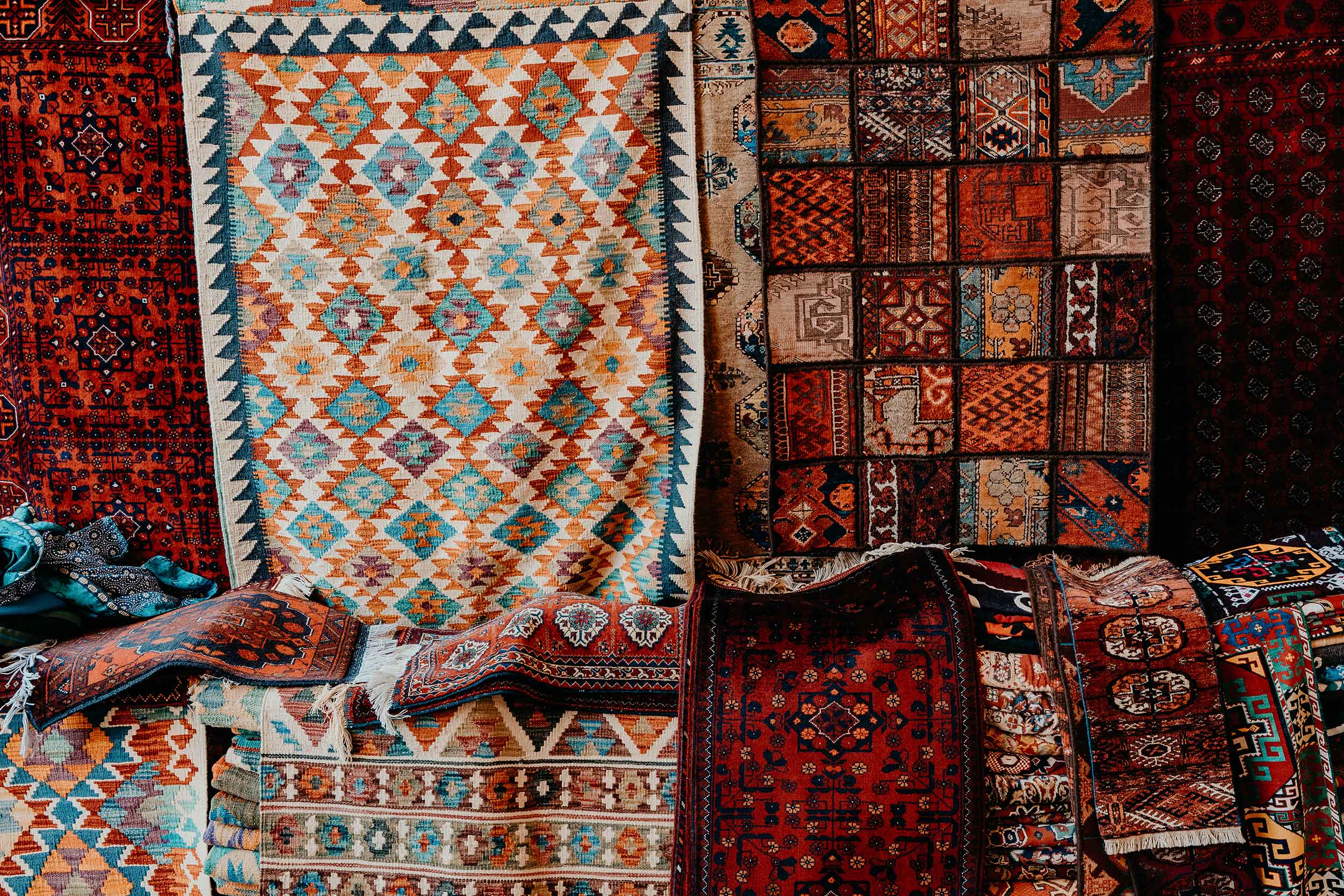
7. Kalyan Minaret
While already name-dropped earlier, I believe the Kalyan Minaret deserves all the praise, as its iconic appearance is witnessed from all over town.
Constructed in 1127, legend has it that the notorious Ghengis Khan was so fascinated by the Minaret’s appearance that he chose to preserve it when he invaded the city in the 13th century.
Defined by its complex ornamental brickwork, towering height at 47 metres, and bands of impressive Kufic calligraphy, the towering Kalyan Minaret is indeed a picture-perfect vista to behold.
Also known as the ‘Tower of Death’, given its notorious reputation as a point of execution during the Middle Ages, criminals were often thrown from atop the minaret as punishment for their unrighteous deeds.
Though an absolute spectacle, legend has it that the architect was far from satisfied with his creation, that he asked to be buried exactly 47 metres from the minaret, so it would fall upon his grave if something happened to the minaret.
Luckily for us, the towering Kalyan Minaret is still standing proud and tall above the mudbrick roofs of Bukhara, meaning we can admire the architect’s remarkable artistic brilliance – because despite his perfectionism, there’s no denying that his creation is of impeccable beauty.
Where | Kalyan Minaret
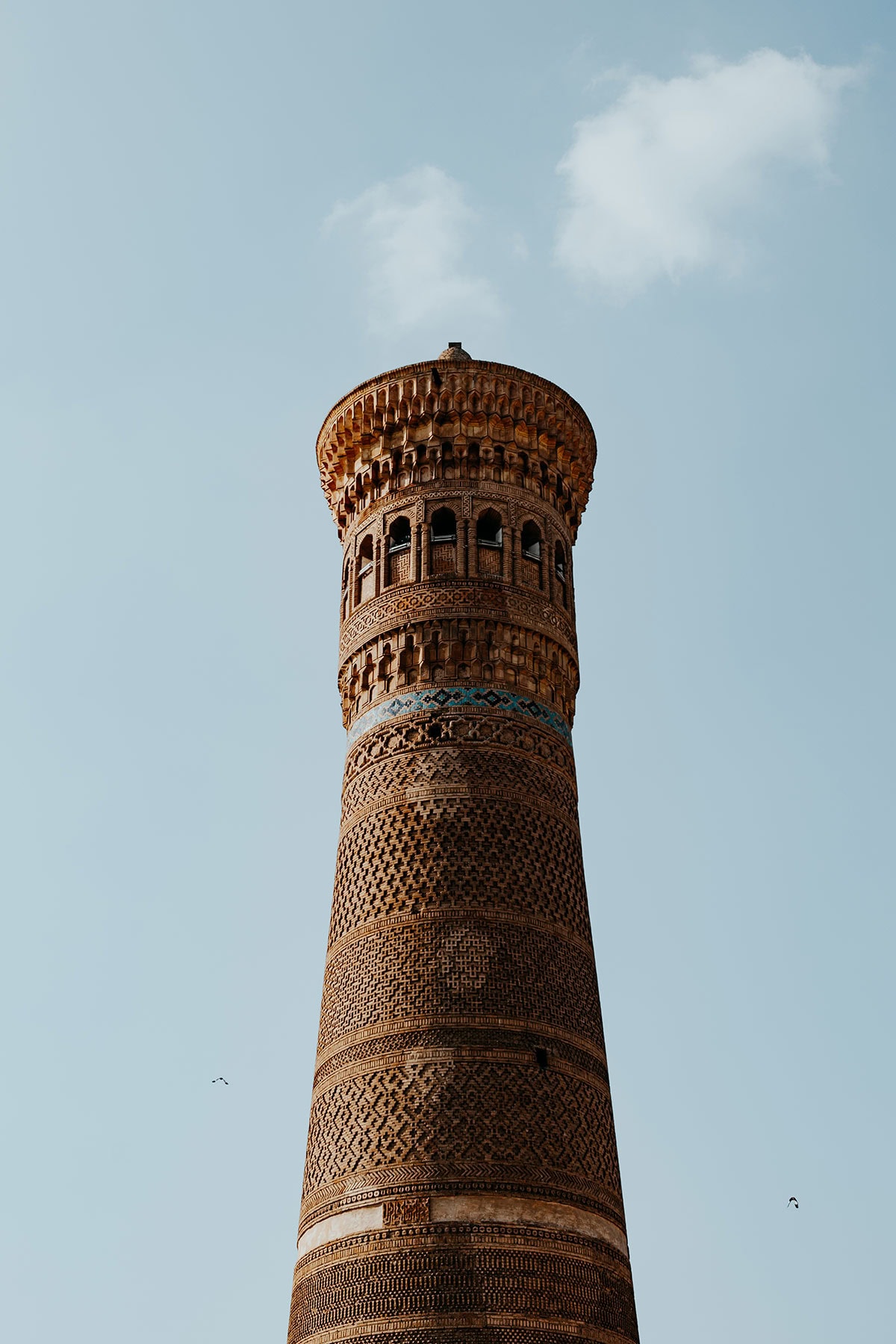
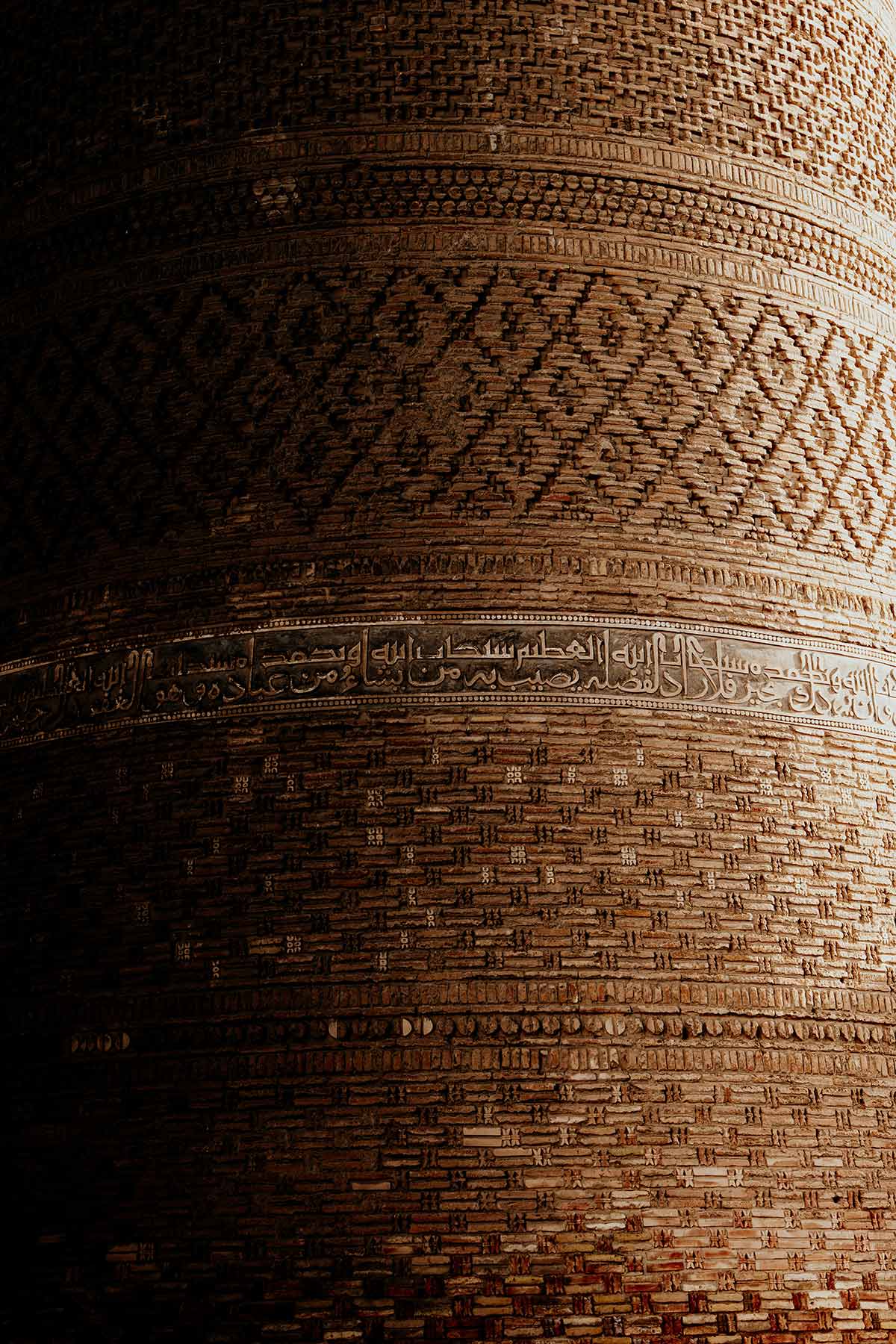
8. Admire the Ismail Samani mausoleum
Often overlooked by other more famous architectural highlights in Bukhara, the minimal yet intricate-looking Ismail Samani Mausoleum is stunning in its own right, with enchanting brickwork and noteworthy geometric patterns throughout.
The Ismail Samani Mausoleum is a classic example of Islamic architecture in Central Asia, while also one of the earliest surviving examples of funerary architecture within the Islamic world.
Constructed between 892 and 943 CE during the Samanid dynasty of Bukhara, the Ismail Samani Mausoleum is among the oldest structures in Bukhara and was once located in the heart of an extensive cemetery.
Today, the mausoleum stands peacefully in Samanidov Park, a charming tree-lined park that makes the perfect setting for the age-old artistry of the mausoleum to stand out.
While the mausoleum is a tad away from Bukhara Old Town, it is surely worth making a small detour, as its cubic-shaped design is downright unique and nothing short of amazing.
Where | Ismail Samani Mausoleum
Opening hours | Daily 0800 – 1800
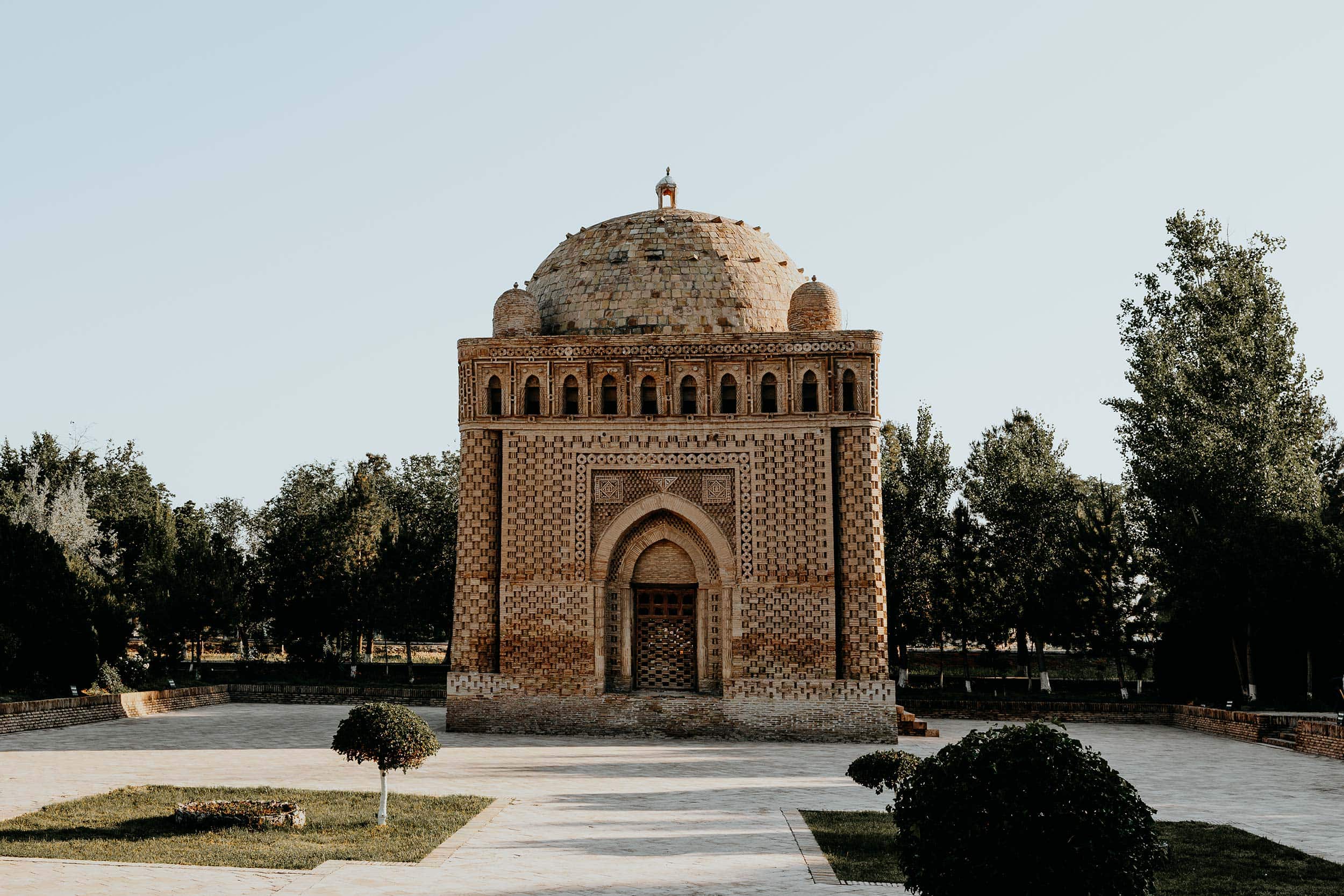
9. Take in the views from the Bukhara Tower
Initially built as a water tower in 1927 by Vladimir Grigorievich Shukhov, the towering structure supplied the people of Bukhara with water for many years, before it went up in flames in 1975.
In the following years, the Bukhara Tower was acknowledged as a historical heritage monument and slowly transitioned into the observation tower we visit today.
Situated just outside the old town, the Bukhara Tower offers a unique bird’s eye view of the enormous Bukhara Ark, as well as an impressive vista of Bukhara Old Town in the distance.
Also known as the Sukhov Observation Tower, its spiralling metal construction is striking against the ancient architecture of the Bolo Khauz and the Ark of Bukhara which lay down below.
At 33 metres high, the observation deck is considered the highest vantage point in Bukhara.
From atop you’ll be welcomed by the most stunning views of the surrounding area, making it a perfect spot for photography enthusiasts.
Where | Bukhara Tower
Opening hours | Daily 0900 – 2200
Entrance fee | 40.000 SOM (€3,-) per person
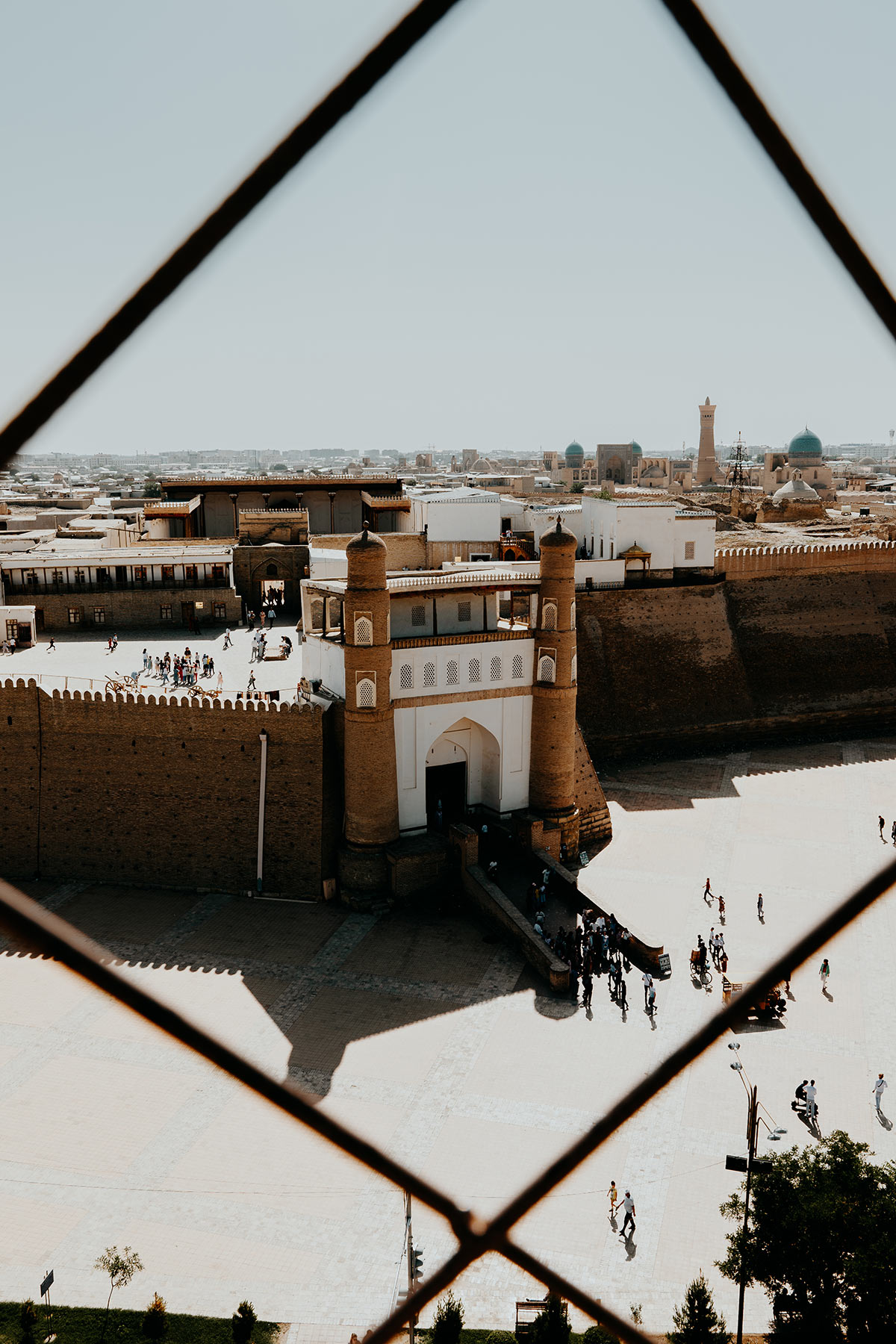
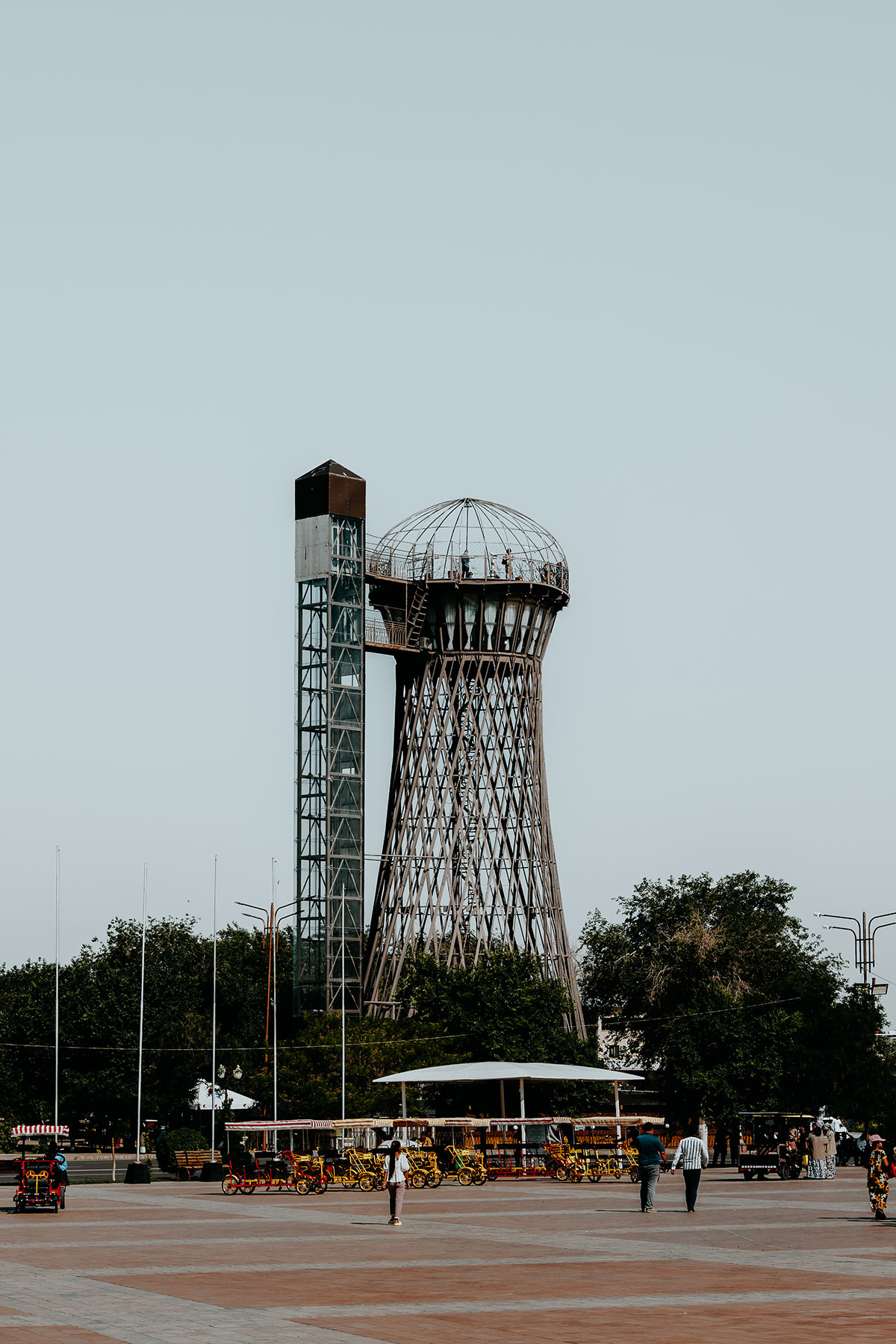
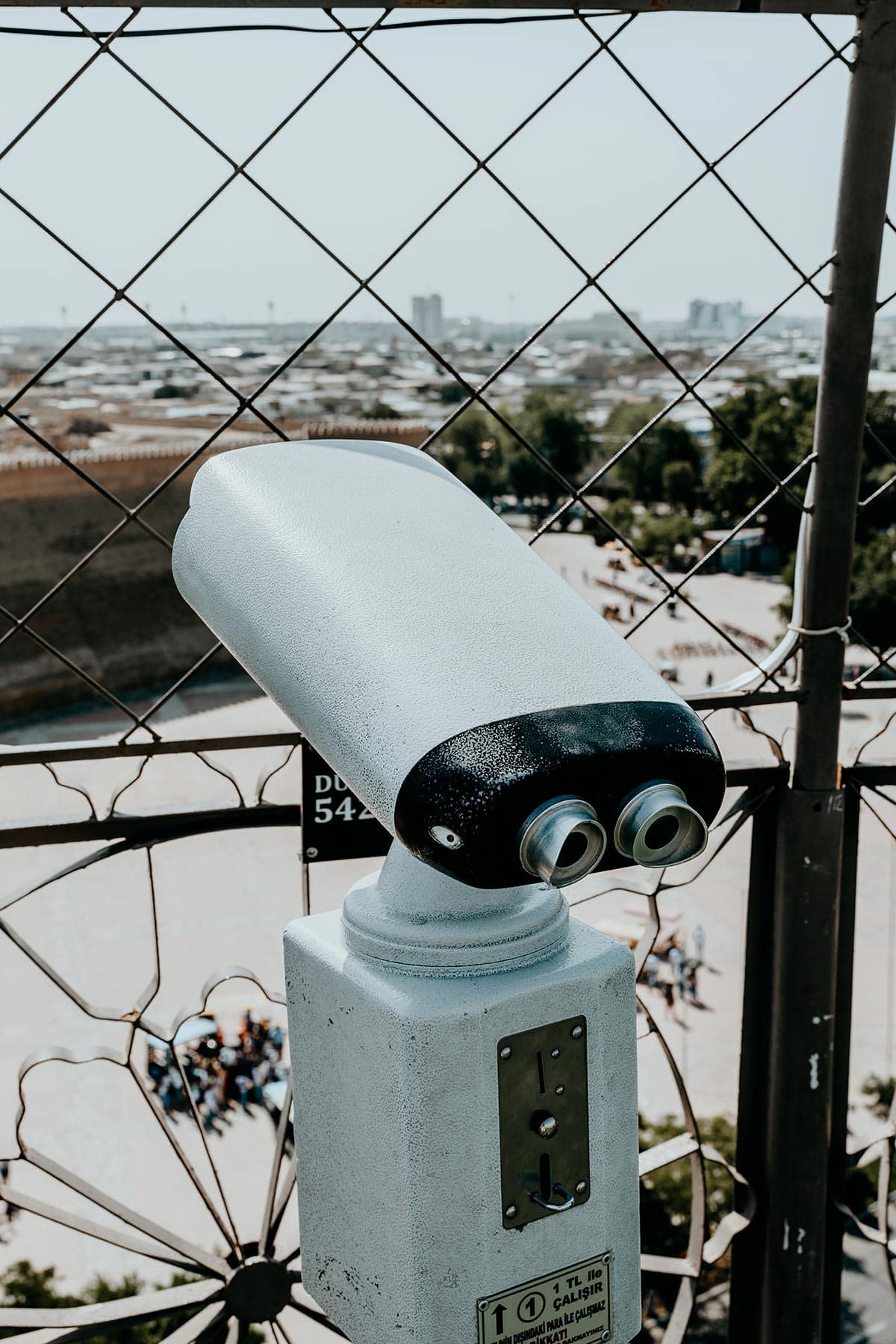
10. Behold the unique Chor Minor
When it comes to unique architectural highlights in Uzbekistan, Chor Minor is definitely one to look out for, as its distinctive design is utterly different from any other structures I’ve seen here.
You see, Chor Minor, also known as ‘Four Minarets’ in Persian, is a small, yet remarkable structure defined by four small minarets-like towers that are atypical to traditional minarets typically seen here in Central Asia.
Tucked away in the backstreets of Bukhara, just a short walk away from the historical centre, Chor Minor reflects the four main religions of the world, as well as four dynasties of rulers in Bukhara.
It tells the story of Bukhara’s rich past, and if you look closely, you will find several interesting feats, including elements related to Christianity and Buddhism. It is relatively obvious to spot a Christian fish, while with a little more imagination a Buddhist prayer wheel is to be seen.
Though we never know the exact story, one thing is fairly sure; Chor Minor was not built as a mosque, but more so a gatehouse to a madrasah, which has sadly diminished throughout the centuries.
Another thing I know for sure is the fact that visiting Chor Minor is easily one of the best things to do in Bukhara, so make sure you plan some time to behold its unique charm while there.
Where | Chor Minor
Opening Hours | Monday to Friday 0800 – 2000
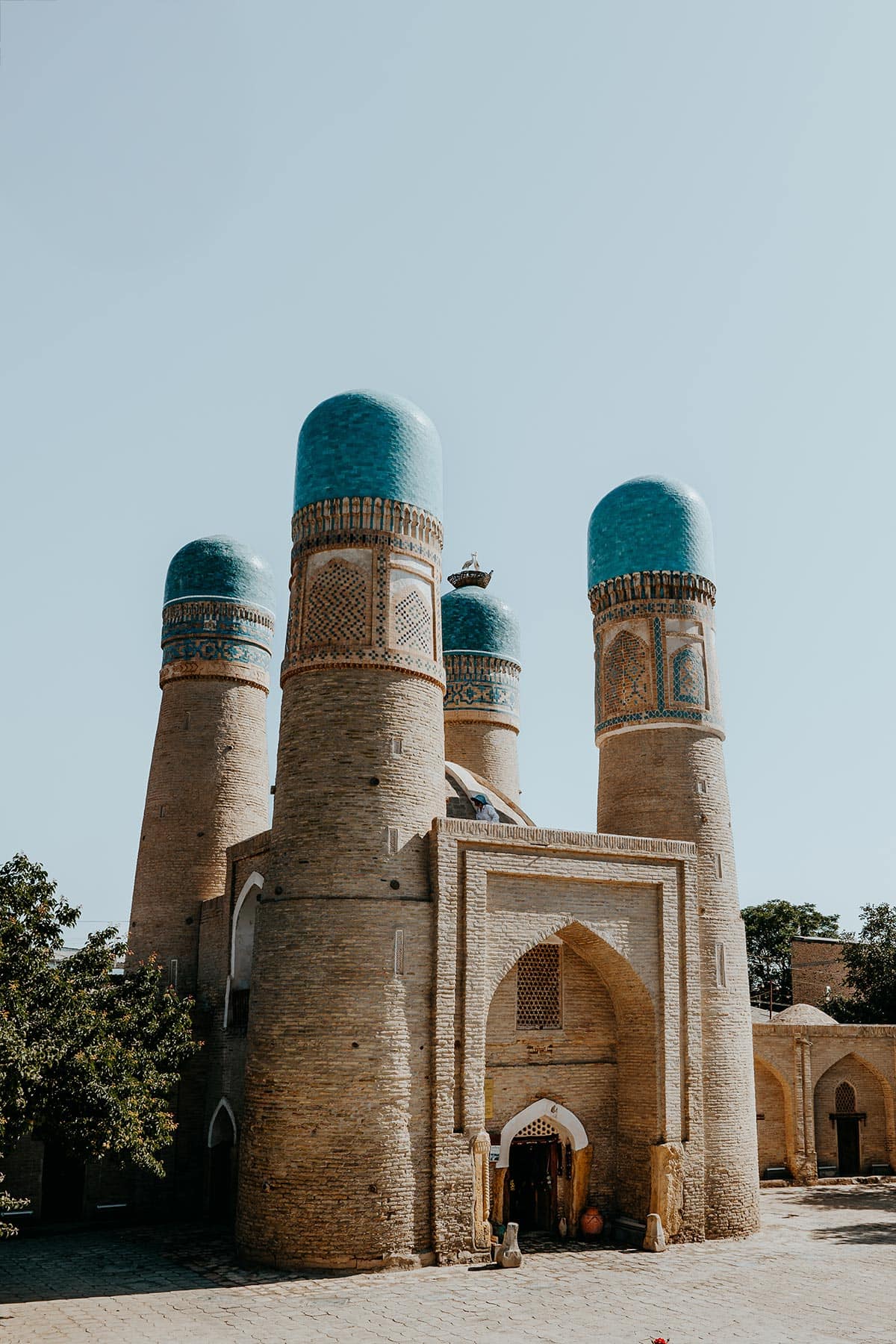
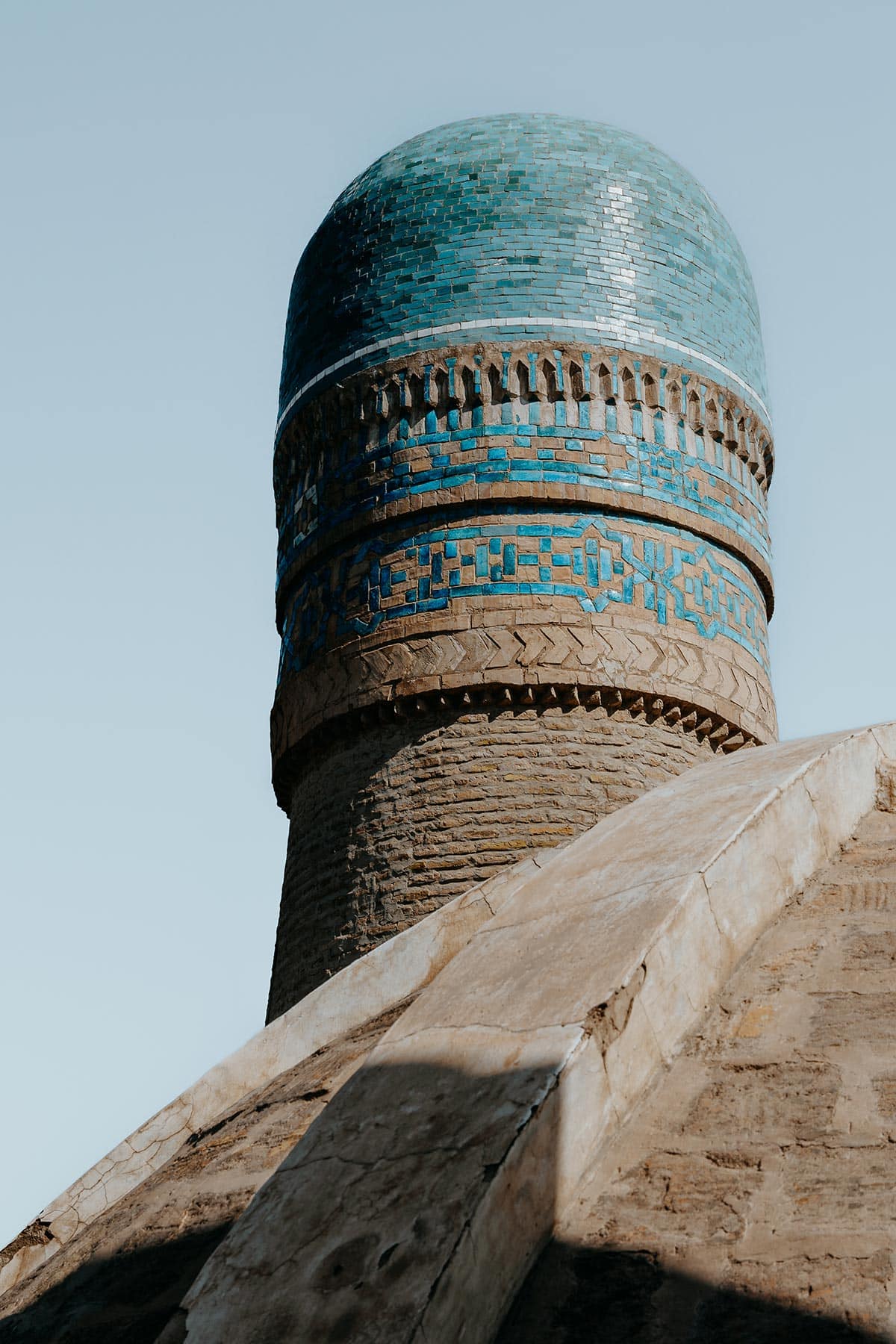
Things to do in Bukhara | The essentials
The best time to visit Bukhara
Being located in the southern part of Uzbekistan, Bukhara experiences a dry continental climate that is characterised by incredibly hot summers and significantly colder winters.
If you can, I’d recommend travelling during the offseason, which for Uzbekistan means from March to June and September to October.
During this time, the temperatures are extremely comfortable, providing the perfect circumstances to go out and about exploring all the amazing places Bukhara has to offer.
Personally, I visited Bukhara in late April, which was brilliant as I had comfortable weather, and lengthy days full of sun, while also having the benefits of a quiet overall experience visiting the popular sights, museums and restaurants.
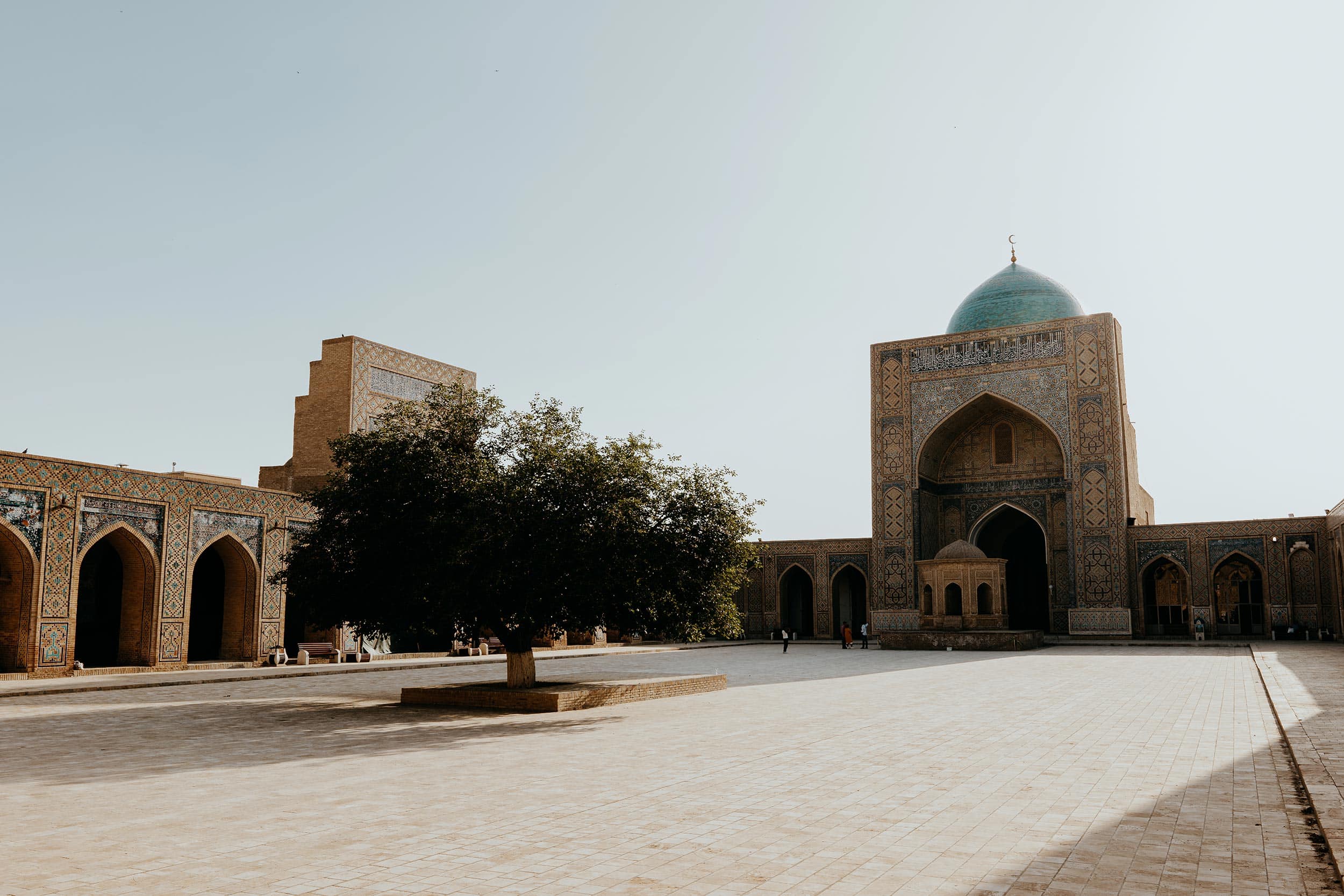
Uzbekistan travel essentials
While Uzbekistan is convenient for travellers, travelling here will come with a unique set of needs, meaning you have to do some kind of preparation before embarking on your journey.
Some items I recommend include:
Uzbekistan SIM card | First things first. Upon arrival in Uzbekistan, I highly recommend buying yourself a local SIM card with a data plan, given it will make anyone’s travels here significantly more convenient. Curious about the details? Read my guide to a Uzbekistan SIM card here.
Reusable water bottle | One travel essential that I carry with me at all times is the Grayl Geopress. This reusable water purification bottle allows me to fill up water from nearly every water source, making it one of my best investments to date.
Sun protection | Since Uzbekistan will most likely be fiery hot during the peak travel months, I’d highly recommend bringing quality sunscreen with at least 30SPF and a hat to cover your head.
Powerbank | When travelling through Uzbekistan, you don’t want to risk being in an uncharted area with an empty device in your hands. For that reason, I believe it’s crucial to carry a power bank with you at all times.
Earpods or headphones | If you’re following this itinerary, I can’t stress it enough to bring some high-end earpods or headphones, given the journey from Bukhara to Khiva by night train can be quite hectic happening.
Camera gear | Like most places in Uzbekistan, Bukhara is absolutely captivating, meaning loads of incredible photography opportunities will arise when exploring. For that reason, I’d highly recommend bringing your camera gear, so you can capture loads of photos while there. If you’re curious to learn about my photography gear, make sure you give my ‘What’s in my Camera Bag’ guide a read too.
Leave no footprints | During my travels in Uzbekistan, I noticed that the cities and their people are really neat when it comes to cleanliness and littering. It’s up to us to respect the locations we’re visiting and keep it that way.
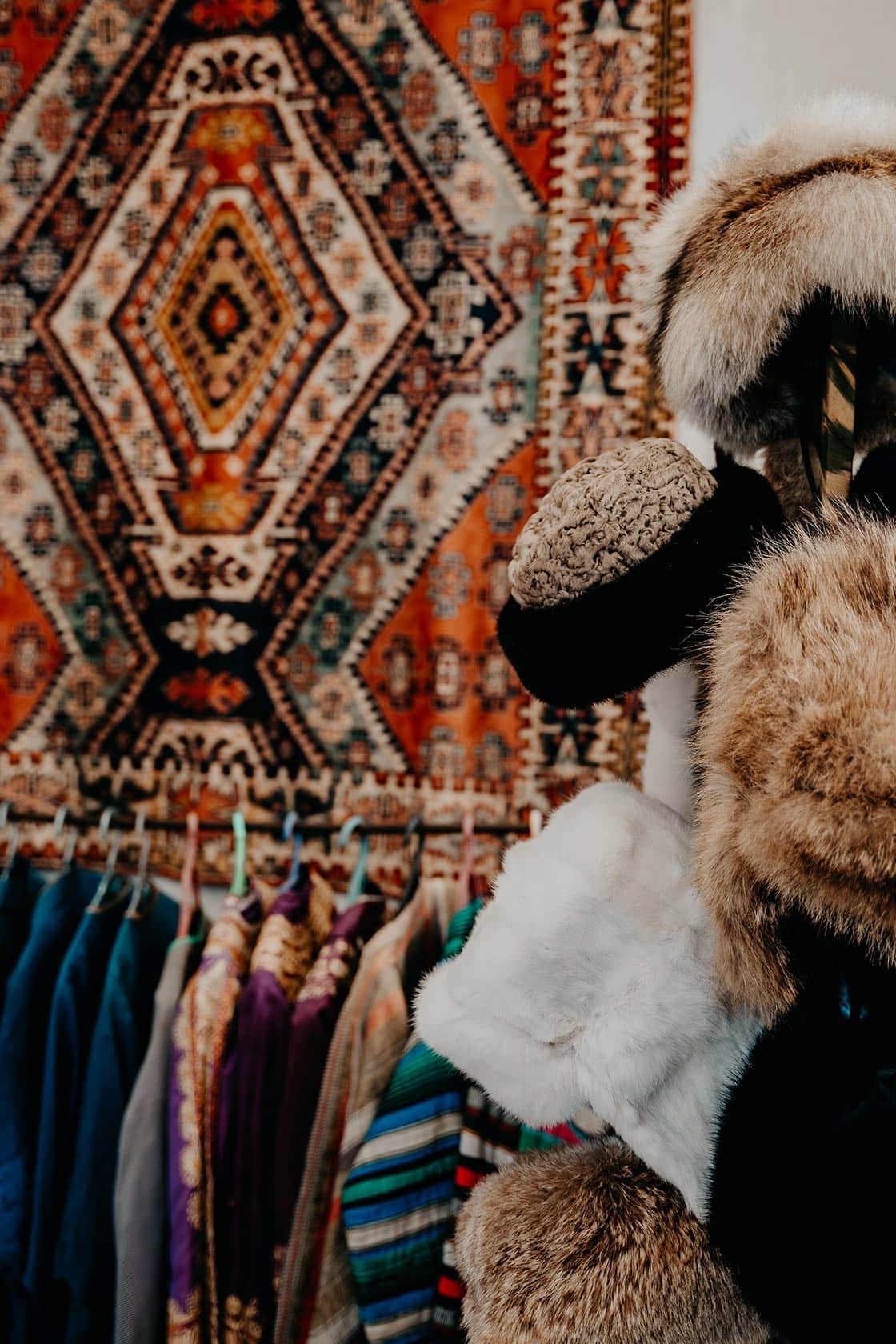
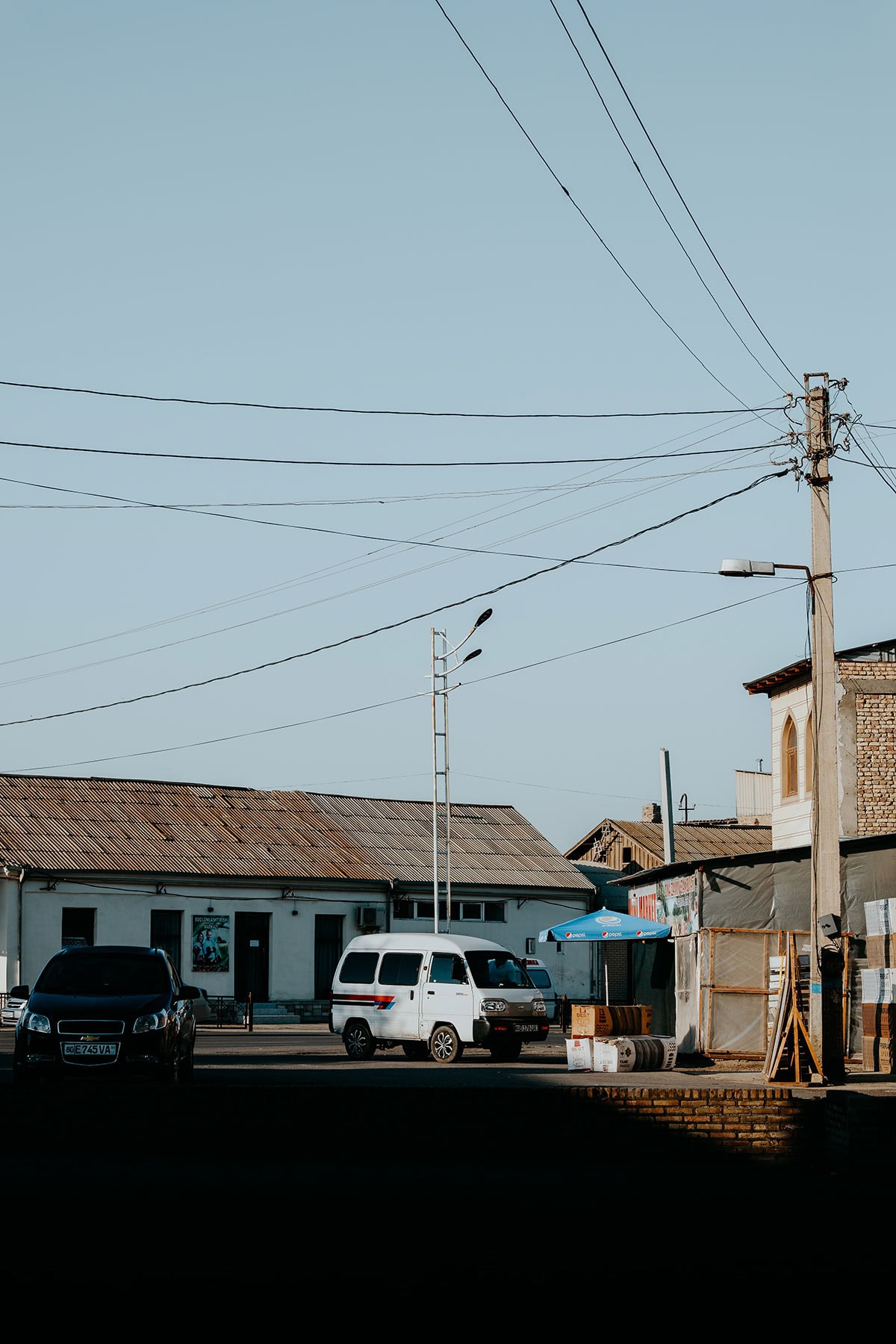
Safety in Uzbekistan | Travel insurance
When travelling this big wide world, I never go on an adventure without my essential travel insurance sorted out, and though I never felt unsafe in Uzbekistan, I advise anyone travelling here to do the same.
While I believe it’s unlikely to experience any problems when following the suggestions in this guide, something unfortunate could happen at any given time, whether it’s an injury, a stolen camera, or an unforeseen cancellation.
For travel insurance, I use Heymondo, as they offer full COVID-19 coverage, as well as a handy app with 24-hour medical assistance. Make sure you check it out – readers of WTSW receive 5% off any insurance policy too.
Cheers!
I’ve been on this travel blogging journey since 2019.
If you appreciate what I do here, these are some ways you can support me.
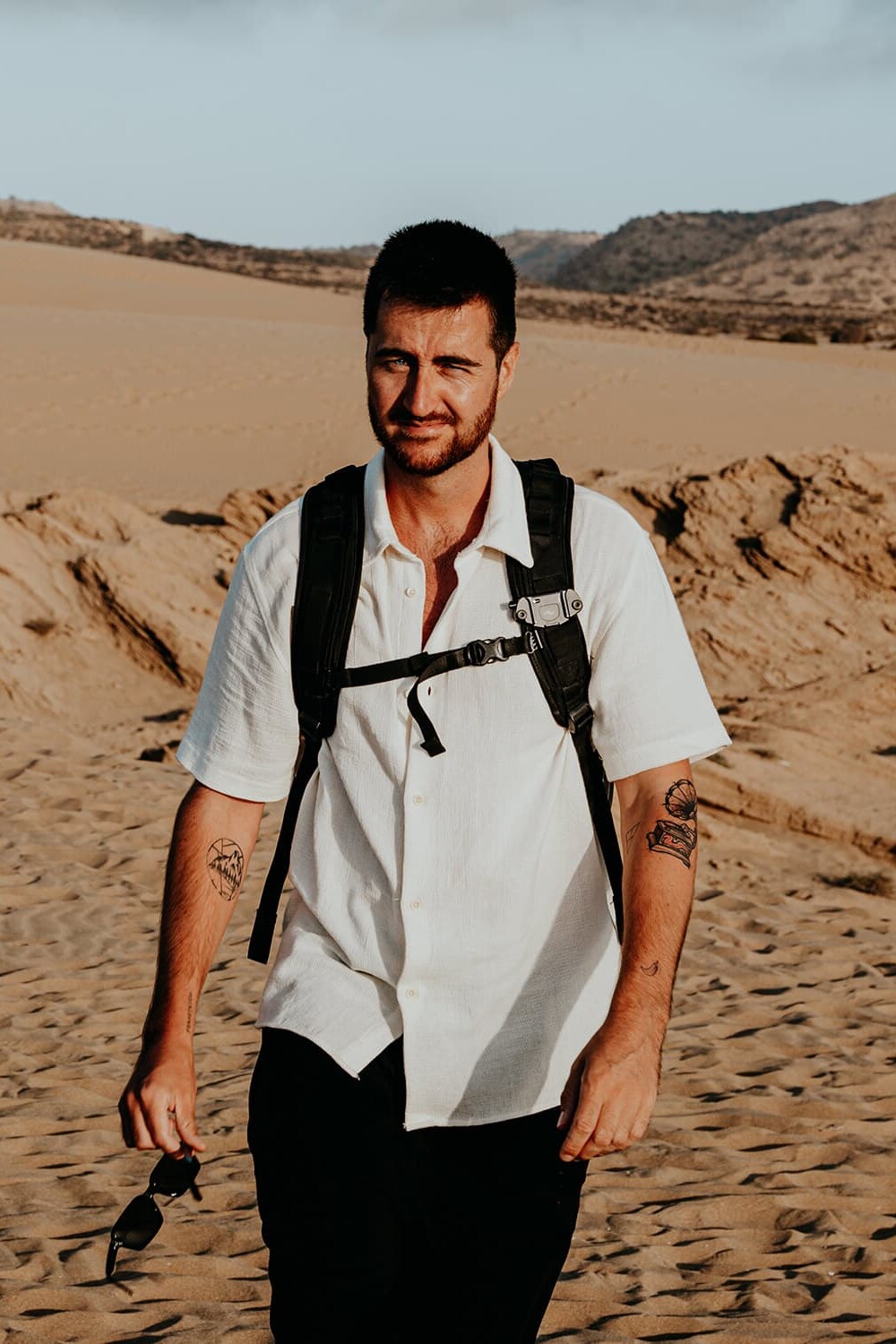
Plan your Uzbekistan itinerary with these essential guides



